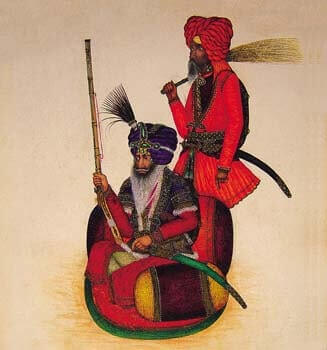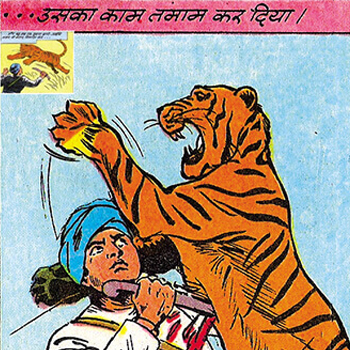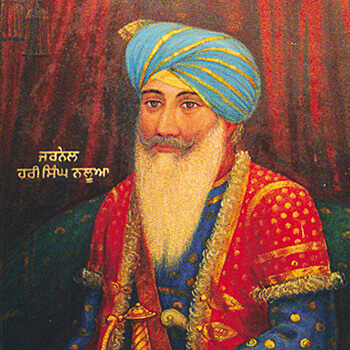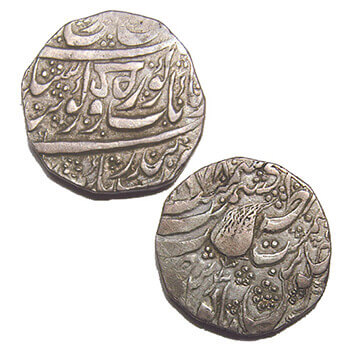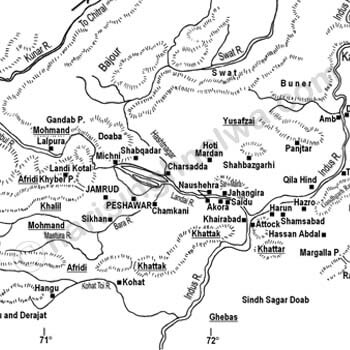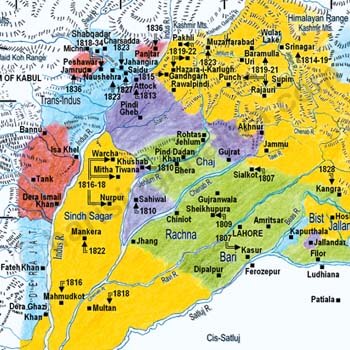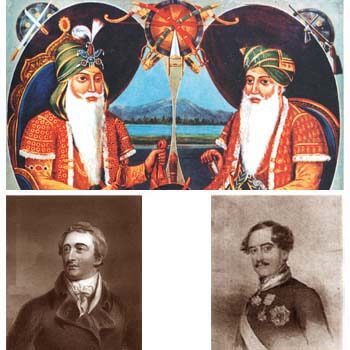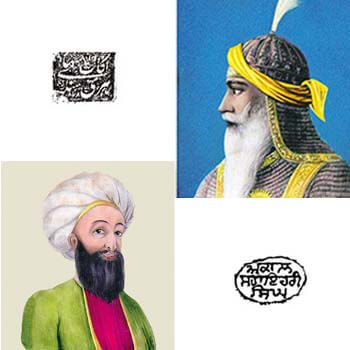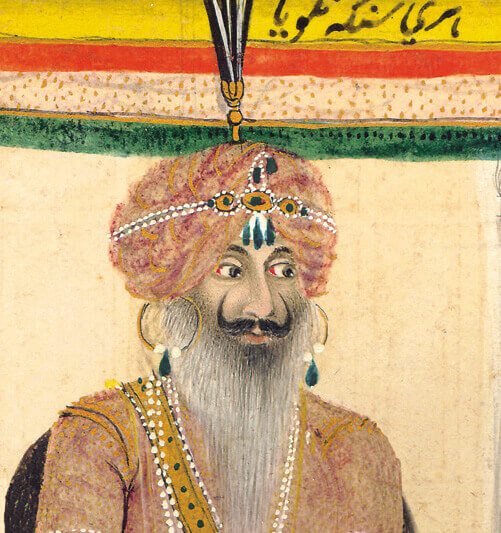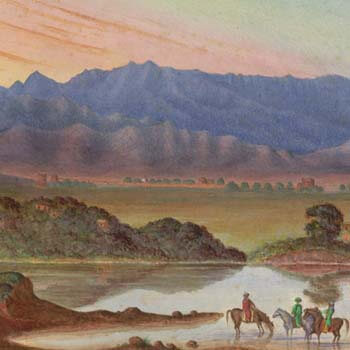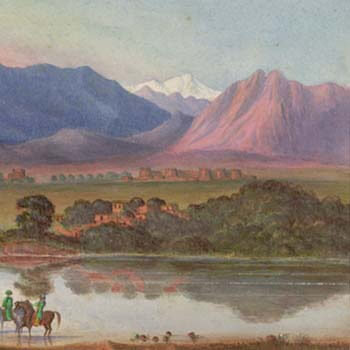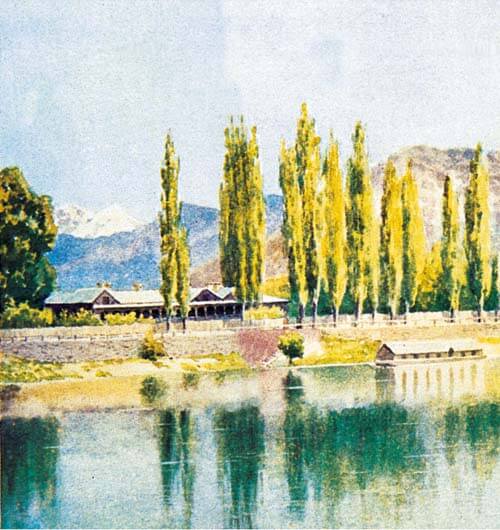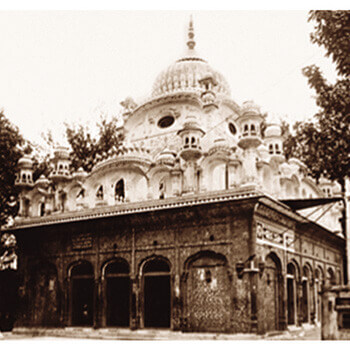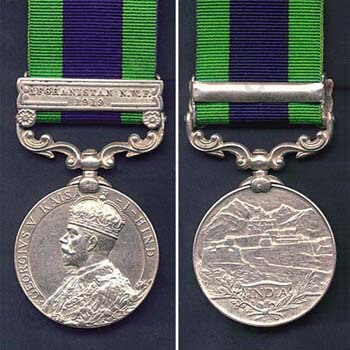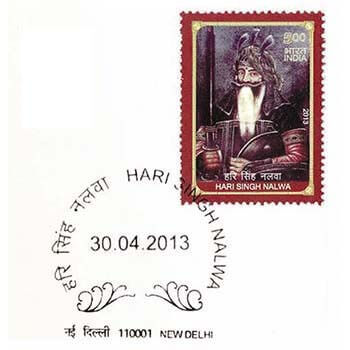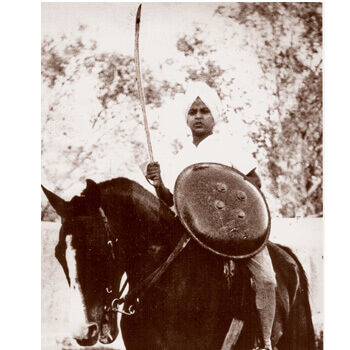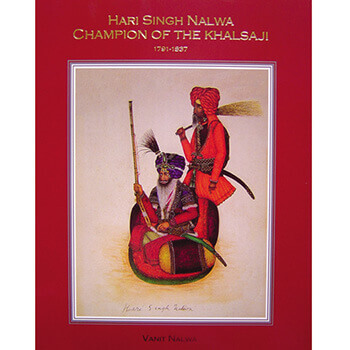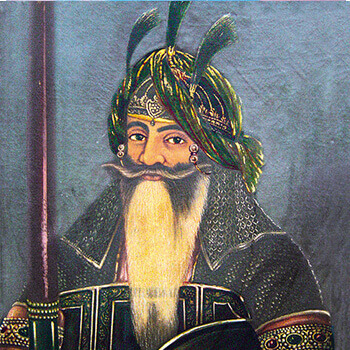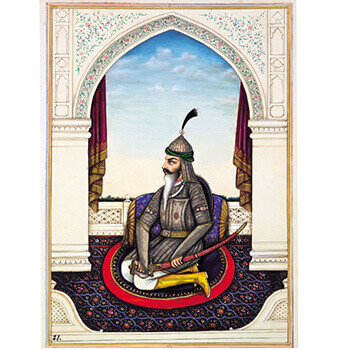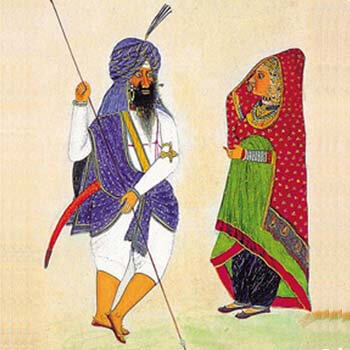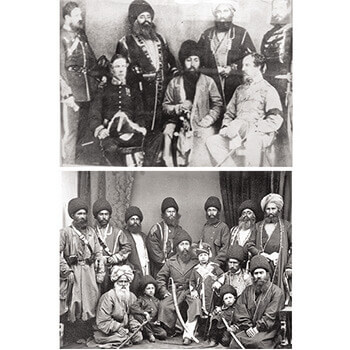ਖ਼ਾਲਸਾ ਜੀ ਦਾ ਚੈਂਪੀਅਨ
ਡਿਓਢ
ਜ਼ੁਲਮ ਤਦੀ ਬਹੁ ਚੁੱਕੀ ਤੁਰਕਾਂ ਕਲਮ ਮੇਰੀ ਫਟ ਜਾਵੇ, ਕਰਦੀ ਹਾਵੇ।
ਦੇਵੀ ਦੇਵਤੇ ਛੱਪ ਖੜੋਤੇ ਕੌਨ ਅਗੇ ਹੁੰਨ ਆਵੇ, ਮੂੰਹ ਦੀ ਖਾਵੇ।
ਮੰਦਰ ਦਿਵਾਲੇ ਢਾਹ ਹਿੰਦੂਆਂ ਸਭ ਮਸੀਤ ਬਨਾਵੇ, ਪੇਸ਼ ਨਾ ਜਾਵੇ।
ਕੁਆਰੀ ਸੁੰਦਰ ਕੰਨਿਆ ਦੇਖੇ ਘਰ ਤੇ ਪਕੜ ਮੰਗਾਵੇ, ਅਨੀਤਿ ਕਮਾਵੇ।
ਲਿਜਾ ਮਸੀਤੇ ਕਰ ਮੁਸਲਮਾਨੀ ਜ਼ੋਰੀ ਨਿਕਾਹ ਪੜ੍ਹਾਵੇ, ਮਹਲੀਂ ਪਾਵੇ।
ਰੋ ਰੋ ਆਹੀਂ ਮਾਰਨ ਹਿੰਦੂ ਕੌਨ ਤਿਨ੍ਹਾਂ ਗਲ ਲਾਵੇ, ਕਰਦੇ ਹਾਵੇ ।
ਹੱਥ ਜੋੜਨ ਤੇ ਨੱਕ ਭੀ ਰਗੜਨ ਦੇਵੀ ਨਹਿਂ ਦਰਸਾਵੇ, ਕਿ ਪਈ ਸ਼ਰਮਾਵੇ।
ਓੜਕ ਨੂੰ ਸੁਣ ਨਾਮ ਸਿੰਘਾਂ ਦਾ ਵਜ਼ੀਰ ਬੀਰਬਲ ਆਵੇ, ਵਾਸਤੇ ਪਾਵੇ।
ਹਥ ਜੋੜ ਬਡ ਦੀਨ ਹੋਇਕੇ ਕਰਦਾ ਜਾਇ ਪੁਕਾਰਾ, ਵਿੱਚ ਦਰਬਾਰਾ।
ਪ੍ਰਜਾ ਅਤਿ ਦੁਖ ਪਾਇ ਭੇਜਦੀ ਸੁਣੋ ਸਿੰਘ ਸਰਦਾਰਾ, ਮਾਨ ਹਮਾਰਾ।
ਧਰਤੀ ਕਿਤੇ ਨ ਝੱਲੇ ਸਾਨੂੰ ਸੁਣੀਓ ਮੇਰੀ ਪੁਕਾਰਾ, ਵਾਸਤੇ ਦਾਤਾਰਾ।
ਫੌਜ ਚੜ੍ਹਾਓ ਫਤਹ ਸਬ ਪਾਓ ਸਾਨੂੰ ਦੇਓ ਛੁਟਕਾਰਾ, ਦੁਖ ਵਡਭਾਰਾ।।੪੧।।
(ਅਮਰ ਸਿੰਘ ਦੀ 1903 ਦੀ ਕਿਤਾਬ ਵਿਚ ਸੀਤਾਰਾਮਾ, 21)
ਇਹ ਡਿਓਢ ਪੰਡਿਤ ਬੀਰਬਲ ਧਾਰ ਦੀ ਸਿੱਖਾਂ ਨੂੰ ਕਸ਼ਮੀਰ ਫ਼ਤਿਹ ਕਰਨ ਲਈ ਬੇਨਤੀ ਸੀ। ਇਹ ਡਿਓਢ ਬਖੂਬੀ ਕਸ਼ਮੀਰ ਵਿਚ ਹਿੰਦੂਆਂ ’ਤੇ ਹੋ ਰਹੇ ਜ਼ੁਲਮਾਂ ਦਾ ਵੇਰਵਾ ਸੀ ਜੋ ਇਹ ਝਲਕ ਵੀ ਦੇਂਦੀ ਸੀ ਕਿ ਬਾਕੀ ਹਿੰਦੁਸਤਾਨ ਵਿਚ ਮੁਸਲਮਾਨਾਂ ਦੇ ਰਾਜ ਵਿਚ ਗ਼ੈਰ-ਮੁਸਲਮਾਨਾਂ ਦਾ ਕੀ ਹਾਲ ਸੀ।
ਸਿੱਖ ਰਾਜ ਦੇ ਆਉਣ ਤੋਂ 800 ਸਾਲ ਪਹਿਲੇ, ਹਿੰਦੁਸਤਾਨ ਦੀ ਧਰਤੀ ਹਿੰਦੂ ਅਤੇ ਬੋਧੀ ਧਰਮਾਂ ਦੇ ਅਸਰ ਹੇਠ ਸੀ। ਇਸਲਾਮ ਧਰਮ ਵਿਚ ਕੀਤੇ ਮੁਢਲੇ ਜਬਰਨ ਬਦਲਾਵ ਅਰਬਾਂ, ਤੁਰਕਾਂ ਤੇ ਈਰਾਨੀ ਧਾੜਵੀਆਂ ਨੇ ਸ਼ੁਰੂ ਕੀਤੇ ਤੇ ਮੁਗ਼ਲਾਂ ਅਧੀਨ ਜਾਰੀ ਰਹੇ। ਅਠਾਰ੍ਹਵੀਂ ਸਦੀ ਦੇ ਉਘੇ ਧਾੜਵੀ ਨਾਦਰ ਸ਼ਾਹ ਈਰਾਨੀ ਤੇ ਅਹਿਮਦ ਸ਼ਾਹ ਅਬਦਾਲੀ ਅਫ਼ਗ਼ਾਨ ਸਨ। ਮੁਸਲਮਾਨਾਂ ਦੀਆਂ ਵੱਖ-ਵੱਖ ਰਾਜ ਕਰਨ ਵਾਲੀਆਂ ਪੀੜ੍ਹੀਆਂ ਸਥਾਈ ਵਸਨੀਕਾਂ ਲਈ ਅਣਗਿਣਤ ਮੁਸੀਬਤਾਂ ਅਤੇ ਸਜ਼ਾ ਬਣ ਕੇ ਆਈਆਂ। ਇਹ ਜ਼ਾਲਮੀ ਕੌਮਾਂ ਹਿੰਦੁਸਤਾਨ ਵਿਚ ਜ਼ਿਆਦਾ ਕਰਕੇ ਉੱਤਰ-ਪੱਛਮੀ ਜ਼ਮੀਨੀ ਰਸਤੇ 'ਖ਼ੈਬਰ ਪਾਸ' ਤੋਂ ਆਈਆਂ ਸਨ। ਏਸ ਲਈ ਕੁਦਰਤੀ ਸੀ ਕਿ ਇਨ੍ਹਾਂ ਦੇ ਹਮਲਿਆਂ ਵੇਲੇ ਲਤਾੜੇ ਜਾਣ ਵਾਲੇ ਇਲਾਕੇ ਉਹ ਸਨ ਜੋ ਏਸ ਰਸਤੇ ਦੇ ਬੂਹੇ ਅੱਗੇ ਸਨ – ਖ਼ੈਬਰ ਤੋਂ ਦਿੱਲੀ ਤਕ ਦਾ ਸਾਰਾ ਰਕਬਾ। ਏਸ ਵਿਚ ਸਾਰੇ ਦਾ ਸਾਰੇ ਪੰਜਾਬ ਸ਼ਾਮਲ ਸੀ।
ਜਰਨੈਲ ਹਰੀ ਸਿੰਘ ਨਲਵਾ ਦੀ ਕਾਮਯਾਬੀ ਦਾ ਪੂਰਾ ਮਹੱਤਵ ਸਮਝਣ ਲਈ, ਇਹ ਜਾਨਣਾ ਬਹੁਤ ਜ਼ਰੂਰੀ ਹੈ ਕਿ ਉਨ੍ਹਾਂ ਨੇ ਕਿਨ੍ਹਾਂ ਦੁਸ਼ਮਣਾਂ ਦੇ ਨਾਲ ਟੱਕਰ ਲਈ। ਹਿੰਦੁਸਤਾਨ ਦੀ ਪਹਿਲੀ ਮਰਦਮ-ਸ਼ੁਮਾਰੀ ਅੰਗ੍ਰੇਜ਼ਾਂ ਦੇ ਸਮੇਂ ਵਿਚ ਸੰਨ 1860 ਵਿਚ ਸ਼ੁਰੂ ਹੋਈ (ਜੋ ਖ਼ਾਲਸਾ ਰਾਜ ’ਤੇ ਕਬਜ਼ਾ ਕਰਨ ਤੋਂ ਤਕਰੀਬਨ ਦਸ ਸਾਲ ਬਾਅਦ ਸੀ)। ਤਦ ਇਹ ਵੇਖਿਆ ਗਿਆ ਕਿ ਹਿੰਦੂਆਂ ਦੀ ਸਭ ਤੋਂ ਵੱਧ ਗਿਣਤੀ ਹਿੰਦੁਸਤਾਨ ਦੇ ਦੱਖਣ ਵਿਚ ਸੀ ਤੇ ਉੱਤਰ ਵੱਲ ਆਉਂਦੇ ਹੋਏ ਲਗਾਤਾਰ ਘਟਦੀ ਜਾਂਦੀ ਸੀ। ਪੰਜਾਬ ਵਿਚ ਉਨ੍ਹਾਂ ਦੀ ਗਿਣਤੀ ਜਲੰਧਰ ਵਿਚ 58% ਰਹਿ ਗਈ ਸੀ। ਅੰਮ੍ਰਿਤਸਰ ਵਿਚ ਹਿੰਦੂਆਂ ਦੀ ਗਿਣਤੀ 24%, ਮੁਲਤਾਨ ਵਿਚ 17%, ਲਾਹੌਰ ਵਿਚ 15%, ਰਾਵਲਪਿੰਡੀ ਵਿਚ 10%, ਡੇਰਾਜਾਤ ਵਿਚ 11% ਤੇ ਪਿਸ਼ਾਵਰ ਵਿਚ 5% ਸੀ।
ਸਿੱਖਾਂ ਦੀ ਸਭ ਤੋਂ ਵੱਧ ਗਿਣਤੀ ਰਾਵੀ ਤੇ ਸਤਲੁਜ ਦਰਿਆਵਾਂ ਦੇ ਵਿਚਕਾਰਲੇ ਇਲਾਕੇ ਵਿਚ ਸੀ¸ ਲਾਹੌਰ ਵਿਚ 17%, ਅੰਮ੍ਰਿਤਸਰ ਵਿਚ 13% ਅਤੇ ਜਲੰਧਰ ਵਿਚ ਸਿਰਫ਼ 8% ਸੀ। ਬਾਕੀ ਖ਼ਾਲਸਾ ਰਾਜ ਦੇ ਇਲਾਕਿਆਂ ਵਿਚ ਸਿੱਖਾਂ ਦੀ ਗਿਣਤੀ 3% ਤੋਂ ਲੈ ਕੇ 300 ਕੁਲ ਆਬਾਦੀ ਪਿੱਛੇ ਸਿਰਫ਼ ਇਕ ਹੀ ਸੀ, ਜਿਵੇਂ ਕਿ ਵਾਟਰਫੀਲਡ ਨੇ 1875 ਵਿਚ ਲਿਖੀ ਇਕ ਕਿਤਾਬ ਵਿਚ ਜ਼ਿਕਰ ਕੀਤਾ ਹੈ। ਏਸ ਦੇ ਮੁਕਾਬਲੇ ਵਿਚ ਮੁਸਲਮਾਨਾਂ ਦੀ ਗਿਣਤੀ ਅੰਮ੍ਰਿਤਸਰ, ਲਾਹੌਰ ਤੇ ਮੁਲਤਾਨ ਵਿਚ 50% ਤੋਂ ਸ਼ੁਰੂ ਹੋ ਕੇ 65% ਤਕ ਸੀ। ਰਾਵਲਪਿੰਡੀ ਤੇ ਡੇਰਾਜਾਤ ਵਿਚ ਇਨ੍ਹਾਂ ਦੀ ਗਿਣਤੀ 85% ਤੋਂ ਵੱਧ ਸੀ। ਪਿਸ਼ਾਵਰ ਵਿਚ 93% ਤੋਂ ਘਟ ਮੁਸਲਮਾਨ ਨਹੀਂ ਸਨ।
ਖ਼ਾਲਸਾ ਰਾਜ ਲਈ ਜਰਨੈਲ ਹਰੀ ਸਿੰਘ ਨਲਵਾ ਦੀਆਂ ਜਿੱਤਾਂ ਉੱਤਰ ਵਿਚ ਕਸ਼ਮੀਰ ਤੋਂ ਲੈ ਕੇ ਦੱਖਣ ਵਿਚ ਮੁਲਤਾਨ ਤਕ, ਪੂਰਬ ਵਿਚ ਕਸੂਰ ਤੋਂ ਲੈ ਕੇ ਪੱਛਮ ਵਿਚ ਜਮਰੌਦ ਤਕ – ਸਰਕਾਰ ਖ਼ਾਲਸਾ ਜੀ ਦੇ ਕੁਲ ਇਲਾਕੇ ਵਿਚ ਹਾਸਿਲ ਕੀਤੀਆਂ ਗਈਆਂ ਸਨ। ਉਹਦੀ ਆਪਣੀ ਨਿਜੀ ਬਹਾਦੁਰੀ, ਹਿੰਮਤ ਅਤੇ ਦਲੇਰੀ ਖ਼ਾਲਸਾ ਫ਼ੌਜ ਦੇ ਇਸ ਕਮਾਂਡਰ ਨੂੰ ਸਦੀਆਂ ਤੋਂ ਵਸਦੇ ਮੁਸਲਮਾਨੀ ਖੇਤਰ ਦੇ ਮੱਧ ਵਿਚ ਲੈ ਗਈ। ਅੱਠ ਸੌ ਸਾਲਾਂ ਦੇ ਇਤਿਹਾਸ ਵਿਚ ਪਹਿਲੀ ਵਾਰ ਇਸ ਹਿੰਦੁਸਤਾਨ ਦੀ ਧਰਤੀ ਦੇ ਇਕ ਲਾਲ ਨੇ ਚੱਟਾਨ ਬਣ ਕੇ 'ਖ਼ੈਬਰ' ਦੇ ਰਾਹ ਆਉਣ ਵਾਲੇ ਹਮਲਾਵਰਾਂ ਦਾ ਰਾਹ ਰੋਕਿਆ।
ਆਪਣੀ ਸੇਵਾ ਦੇ ਮੁਢਲੇ ਸਾਲਾਂ ਵਿਚ 'ਮਾਰਸ਼ਲ ਆਫ਼ ਦ ਖ਼ਾਲਸਾ' ਨੇ ਸਰਦਾਰੀ ਫ਼ੌਜਾਂ ਦੀ ਅਗਵਾਈ ਕੀਤੀ। ਨਯੀਅਰ ਨੇ ਆਪਣੀ 1993 ਦੀ ਪੁਸਤਕ ਵਿਚ ਵੇਰਵਾ ਦਿੱਤਾ ਹੈ। ਸੰਨ 1816 ਵਿਚ, ਮਹਾਰਾਜਾ ਰਣਜੀਤ ਸਿੰਘ ਨੇ ਅਤਰ ਸਿੰਘ ਫ਼ੈਜ਼ਲਪੁਰੀਆ ਨੂੰ ਆਪਣੀਆਂ ਫ਼ੌਜਾਂ ਸਮੇਤ ਹਰੀ ਸਿੰਘ ਹੇਠ ਕੰਮ ਕਰਨ ਲਈ ਨਿਯੁਕਤ ਕੀਤਾ। ਆਪਣੀ ਸੇਵਾ ਦੇ ਮੁਢਲੇ ਸਾਲਾਂ ਵਿਚ 'ਮਾਰਸ਼ਲ ਆਫ਼ ਦ ਖ਼ਾਲਸਾ' ਨੇ ਸਰਦਾਰੀ ਫ਼ੌਜਾਂ ਦੀ ਅਗਵਾਈ ਕੀਤੀ। ਨਯੀਅਰ ਨੇ ਆਪਣੀ 1993 ਦੀ ਪੁਸਤਕ ਵਿਚ ਵੇਰਵਾ ਦਿੱਤਾ ਹੈ। ਸੰਨ 1816 ਵਿਚ, ਮਹਾਰਾਜਾ ਰਣਜੀਤ ਸਿੰਘ ਨੇ ਅਤਰ ਸਿੰਘ ਫ਼ੈਜ਼ਲਪੁਰੀਆ ਨੂੰ ਆਪਣੀਆਂ ਫ਼ੌਜਾਂ ਸਮੇਤ ਹਰੀ ਸਿੰਘ ਹੇਠ ਕੰਮ ਕਰਨ ਲਈ ਨਿਯੁਕਤ ਕੀਤਾ। ਦਰਬਾਰ ਦੀ ਉਨੀਵੀਂ ਸਦੀ ਦੀਆਂ ਲਿਖਤਾਂ ਵਿਚ ਵਰਨਣ ਹੈ। ਭੰਗੀ ਮਿਸਲ ਦੇ ਸਰਦਾਰ ਦੇ ਪੁੱਤਰ ਗੁਰਦਿੱਤ ਸਿੰਘ ਨੂੰ ਸਰਦਾਰ ਨਲਵਾ ਦੀ ਕਮਾਨ ਹੇਠ ਭੇਜਿਆ। ਅਲੀਉਦੀਨ ਦੇ ਇਬਰਤਨਾਮਾ ਵਿਚ ਜ਼ਿਕਰ ਆਉਂਦਾ ਹੈ। ਰਾਮਗੜ੍ਹੀਆ ਤੇ ਨਿਹੰਗ ਫ਼ੌਜਾਂ ਨੇ ਵੀ ਸਰਦਾਰ ਹੇਠ ਕੰਮ ਕੀਤਾ ਸੀ।ਦਰਬਾਰ ਦੀ ਉਨੀਵੀਂ ਸਦੀ ਦੀਆਂ ਲਿਖਤਾਂ ਵਿਚ ਵਰਨਣ ਹੈ। ਭੰਗੀ ਮਿਸਲ ਦੇ ਸਰਦਾਰ ਦੇ ਪੁੱਤਰ ਗੁਰਦਿੱਤ ਸਿੰਘ ਨੂੰ ਸਰਦਾਰ ਨਲਵਾ ਦੀ ਕਮਾਨ ਹੇਠ ਭੇਜਿਆ। ਅਲੀਉਦੀਨ ਦੇ ਇਬਰਤਨਾਮਾ ਵਿਚ ਜ਼ਿਕਰ ਆਉਂਦਾ ਹੈ। ਰਾਮਗੜ੍ਹੀਆ ਤੇ ਨਿਹੰਗ ਫ਼ੌਜਾਂ ਨੇ ਵੀ ਸਰਦਾਰ ਹੇਠ ਕੰਮ ਕੀਤਾ ਸੀ।
ਜਰਨੈਲ ਹਰੀ ਸਿੰਘ ਦੀ, ਸੰਨ 1834 ਤਕ, ਪ੍ਰਸਿੱਧੀ ਏਨੀ ਜ਼ਬਰਦਸਤ ਸੀ ਕਿ ਉਹਦੇ ਆਉਣ ਦੀ ਖ਼ਬਰ ਸੁਣਦੇ ਹੀ ਪਿਸ਼ਾਵਰ ਖ਼ਾਲੀ ਹੋ ਗਿਆ ਤੇ ਸਿੱਖ ਫ਼ੌਜਾਂ ਨੇ ਉਥੇ ਕਬਜ਼ਾ ਕਰ ਲਿਆ। ਇਸ ਮੌਕੇ ’ਤੇ ਮਹਾਰਾਜੇ ਦਾ ਪੋਤਰਾ, ਹਰੀ ਸਿੰਘ ਦੇ ਨਾਲ ਆਪਣੀ ਪਹਿਲੀ ਮੁਹਿੰਮ ਤੇ ਗਿਆ ਸੀ। ਉਸ ਮੌਕੇ ’ਤੇ ਸ਼ਹਿਜ਼ਾਦੇ ਦੀ ਸੁਰੱਖਿਆ, ਹਰੀ ਸਿੰਘ ਦੀ ਸਭ ਤੋਂ ਵੱਡੀ ਜ਼ਿੰਮੇਵਾਰੀ ਸੀ। ਅਗਲੇ ਸਾਲ ਦੋਸਤ ਮੁਹੰਮਦ ਖ਼ਾਨ ਆਪਣੀਆਂ ਫ਼ੌਜਾਂ ਲੈ ਕੇ, ਖ਼ਾਲਸਾ ਰਾਜ ਤੋਂ ਪਿਸ਼ਾਵਰ ਖੋਹਣ ਲਈ ਕਾਬੁਲ ਤੋਂ ਆਇਆ। ਇਸ ਮੌਕੇ ’ਤੇ ਸਿੱਖ ਫ਼ੌਜ ਨੇ ਕਾਬੁਲ ਫ਼ੌਜ ਦੇ ਅੱਗੇ ਅੱਧੇ ਗੋਲੇ ਰੂਪ ਇੰਜ ਘੇਰਾ ਪਾਇਆ ਕਿ ਕਾਬਲੀਆਂ ਲਈ ਦੌੜਨ ਵਾਸਤੇ ਸਿਰਫ਼ 'ਖ਼ੈਬਰ' ਦਾ ਰਸਤਾ ਹੀ ਰਹਿ ਗਿਆ ਸੀ। ਦੋਸਤ ਮੁਹੰਮਦ ਨੇ ਇਸ ਮੌਕੇ ਦਾ ਪੂਰਾ ਫ਼ਾਇਦਾ ਉਠਾਇਆ ਤੇ ਉਹ ਸਿੱਖ ਫ਼ੌਜ ਨਾਲ ਲੜੇ ਬਗ਼ੈਰ ਉਸ ਰਸਤੇ ਵਾਪਿਸ ਖਿਸਕ ਗਿਆ।
ਜਰਨੈਲ ਹਰੀ ਸਿੰਘ ਨਲਵੇ ਦੀ ਜਮਰੌਦ ਹਾਸਿਲ ਕਰਨ ਦੀ ਜਿੱਤ ਨੇ ਉਸਨੂੰ ਉਸ ਪਿੰਡ ਦਾ ਕਬਜ਼ਾ ਦਿੱਤਾ ਜਿਸਨੇ ਉਸ ਨੂੰ 'ਖ਼ੈਬਰ' ਦਾ ਰਾਹ ਕੰਟਰੋਲ ਕਰਨ ਵਾਲੇ ਕਬੀਲਿਆਂ ਤੇ ਹਾਵੀ ਹੋਣ ਦਾ ਮੌਕਾ ਦਿੱਤਾ। ਇਸ ਜਿੱਤ ਦੇ ਨਾਲ ਕਾਬੁਲ ਦਾ ਰਾਹ ਸਿੱਖ ਫ਼ੌਜ ਲਈ ਖੁੱਲ੍ਹ ਗਿਆ। ਪ੍ਰਿਸਿਪ 1846 ਵਿਚ ਲਿਖੀ ਕਿਤਾਬ ਵਿਚ ਵਰਨਣ ਕਰਦਾ ਹੈ। ਮਹਾਰਾਜਾ ਰਣਜੀਤ ਸਿੰਘ ਦੇ ਆਦੇਸ਼ ਦੇ ਵਿਪਰੀਤ, ਹਰੀ ਸਿੰਘ ਨਲਵਾ ਨੇ ਕਾਬੁਲ ਦੇ ਅਫ਼ਗ਼ਾਨਾਂ ਨਾਲ ਉਸ ਵੇਲੇ ਲੜਾਈ ਕੀਤੀ ਜਦੋਂ ਅਫ਼ਗ਼ਾਨਾਂ ਨੇ ਜਮਰੌਦ ਦੇ ਕਿਲ੍ਹੇ ’ਤੇ ਧਾਵਾ ਬੋਲਿਆ ਜਿਸ ਵਿਚ ਉਹਦੀ ਫ਼ੌਜ ਦੇ ਕੁਝ ਆਦਮੀ ਤੈਨਾਤ ਸਨ। ਜਦੋਂ ਜਰਨੈਲ ਹਰੀ ਸਿੰਘ ਨੂੰ ਪਿਸ਼ਾਵਰ ਵਿਚ ਖ਼ਬਰ ਪਹੁੰਚੀ ਕਿ ਇਸ ਕਿਲ੍ਹੇ ਦੀ ਇਕ ਦੀਵਾਰ ਢਹਿ ਗਈ ਹੈ ਤਾਂ ਉਸਨੂੰ ਸਪਸ਼ਟ ਹੋ ਗਿਆ ਕਿ ਉਹਦੇ ਆਦਮੀ ਪਿਆਸ ਨਾਲ ਜੇ ਨਹੀਂ ਮਰੇ ਤਾਂ ਦੁਸ਼ਮਣ ਦੀ ਗੋਲੀ ਨਾਲ ਜ਼ਰੂਰ ਮਰ ਜਾਣਗੇ। ਹਰੀ ਸਿੰਘ ਨਲਵਾ ਆਪਣੀ 10,000 ਆਦਮੀਆਂ ਦੀ ਫ਼ੌਜ ਲੈ ਕੇ ਪੂਰੀ ਅਫ਼ਗ਼ਾਨ ਫ਼ੌਜ ਜੋ ਉਸਦੀ ਫ਼ੌਜ ਨਾਲੋਂ ਕਈ ਗੁਣਾ ਵੱਧ ਸੀ ਤੇ ਜਿਸ ਨਾਲ ਉਸ ਇਲਾਕੇ ਦੇ ਪਹਾੜੀ ਕਬੀਲੇ ਵੀ ਸ਼ਾਮਿਲ ਸਨ, ਨਾਲ ਲੜਨ ਲਈ ਨਿਕਲ ਪਿਆ। ਏਸ ਜੰਗ ਵਿਚ, ਘਟ ਤੋਂ ਘਟ ਅੰਦਾਜ਼ੇ ਮੁਤਾਬਕ ਵੀ ਇਕ ਸਿੱਖ ਪੰਜ ਦੁਸ਼ਮਣਾਂ ਨਾਲ ਟੱਕਰ ਲੈ ਰਿਹਾ ਸੀ। ਜਰਨੈਲ ਹਰੀ ਸਿੰਘ ਨੇ ਆਪਣੀ ਜ਼ਿੰਦਗੀ ਵਿਚ ਬਥੇਰੀ ਵਾਰ ਇਹੋ ਜਿਹੇ ਮੁਕਾਬਲੇ ਕੀਤੇ ਸਨ। ਪਰ ਇਸ ਮੌਕੇ ’ਤੇ ਫ਼ੌਜ ਦਾ ਵੱਡਾ ਹਿੱਸਾ ਖ਼ੁਸ਼ਾਲ ਸਿੰਘ ਦੇ ਭਤੀਜੇ ਤੇਜ ਸਿੰਘ ਦੇ ਆਦਮੀਆਂ ਦਾ ਸੀ ਅਤੇ ਬੜੀ ਥੋੜ੍ਹੀ ਤਦਾਦ ਉਹਦੇ ਆਪਣੇ ਆਦਮੀਆਂ ਦੀ ਸੀ। ਖ਼ੁਸ਼ਾਲ ਸਿੰਘ ਤੇ ਉਸਦਾ ਭਤੀਜਾ ਦੋਵੇਂ ਹਰੀ ਸਿੰਘ ਦੇ ਖ਼ਿਲਾਫ਼ ਜਾਣੇ ਜਾਂਦੇ ਸਨ। ਇਸ ਤਰ੍ਹਾਂ ਘਟ ਆਦਮੀ ਹੋਣ ਦੇ ਇਲਾਵਾ ਹਰੀ ਸਿੰਘ ਦੀ ਕਮਾਨ ਹੇਠ ਜ਼ਿਆਦਾ ਫ਼ੌਜੀਆਂ ਤੇ ਭਰੋਸਾ ਵੀ ਨਹੀਂ ਸੀ ਕੀਤਾ ਜਾ ਸਕਦਾ।
''ਬਰਨਜ਼' ਦੇ ਇਕ ਅੰਗ੍ਰੇਜ਼ ਸਾਥੀ ਨੇ ਲਿਖਿਆ – “ਮੇਰੇ ਮਾਸ਼ਦ ਵਿਚ ਰਿਹਾਇਸ਼ ਦੌਰਾਨ ਅਬਾਸ ਮਿਰਜ਼ਾ ਦੇ ਕਾਬਲੀ ਤੇ ਤੁਰਕਸਤਾਨੀ ਜਾਸੂਸ ਲਗਾਤਾਰ ਹੈਂਕੜੇ ਨਾਲ ਕਸ਼ਮੀਰ ਨੂੰ ਜਿੱਤਣ ਬਾਰੇ ਕਹਿੰਦੇ ਸਨ ਅਤੇ ਆਪਣੇ ਹੰਕਾਰ ਨਾਲ ਕਿਸੇ ਵੀ ਤਾਕਤ ਨੂੰ ਮੁਕਾਬਲਾ ਕਰਨ ਦੇ ਕਾਬਿਲ ਨਹੀਂ ਵੇਖਦੇ ਸਨ। ਇਥੋਂ ਤਕ ਕਿ ਖ਼ੁਦ ਸ਼ਹਿਜ਼ਾਦਾ ਆਪਣੇ ਗ਼ਰੂਰ ਨੂੰ ਨਹੀਂ ਸੀ ਛੁਪਾ ਸਕਿਆ ਤੇ ਜਦ ਉਸਨੇ ਮੇਰੇ ਸਾਥੀ ਮੋਹਨ ਲਾਲ ਨਾਲ ਮਾਸ਼ਦ ਵਿਚ ਮੁਲਾਕਾਤ ਕੀਤੀ ਤਾਂ ਸ਼ਹਿਜ਼ਾਦੇ ਨੇ ਰਣਜੀਤ ਸਿੰਘ ਦੀ ਫ਼ੌਜ, ਮਾਲੀ ਹਾਲਤ ਤੇ ਰਸਦ ਪ੍ਰਬੰਧ ਦੇ ਬਾਰੇ ਜਦ ਪੁੱਛਿਆ ਤਾਂ ਇਹ ਦਿੱਲੀ ਦੇ ਵਿਦਿਆਰਥੀ ਨੇ ਖੁਲ੍ਹੇ ਸ਼ਬਦਾਂ ਵਿਚ ਜਵਾਬ ਦਿੱਤਾ ਜੋ ਸ਼ਾਇਦ ਸ਼ਹਿਜ਼ਾਦੇ ਨੂੰ ਹਜ਼ਮ ਨਾ ਹੋਇਆ...”। ਨੈਸ਼ਨਲ ਆਰਕਾਈਵਜ਼ ਦੇ ਵਿਦੇਸ਼ ਵਿਭਾਗ ਦੇ ਪੱਤਰਾਂ ਵਿਚ ਵੇਰਵਾ ਮਿਲਦਾ ਹੈ।
ਜਦੋਂ ਇਕ ਵਜ਼ੀਰ ਨੇ 'ਈਸਟ ਇੰਡੀਆ ਕੰਪਨੀ' ਦੇ ਮੁਲਾਜ਼ਮ ਮੋਹਨ ਲਾਲ ਤੋਂ ਪੁੱਛਿਆ ਕਿ ਦੋਵਾਂ ਵਿਚੋਂ ਕੌਣ ਵੱਧ ਤਾਕਤਵਰ ਹੈ – ਅੰਗ੍ਰੇਜ਼ ਜਾਂ ਰਣਜੀਤ ਸਿੰਘ। ਮੋਹਨ ਲਾਲ ਨੇ ਜਵਾਬ ਦਿੱਤਾ – “ਓ ਵਜ਼ੀਰ! ਭਾਵੇਂ ਰਣਜੀਤ ਸਿੰਘ ਅੰਗ੍ਰੇਜ਼ਾਂ ਦੇ ਬਰਾਬਰ ਦੀ ਤਾਕਤ ਨਹੀਂ ਰਖਦਾ, ਫੇਰ ਵੀ ਸਾਰੇ ਹਿੰਦੋਸਤਾਨ ਵਿਚ ਇਕ ਉਹੀ ਉਨ੍ਹਾਂ ਦੀ ਟੱਕਰ ਦਾ ਹੈ”। ਅੰਗ੍ਰੇਜ਼ ਹਕੂਮਤ ਦਾ ਲਿਖਾਰੀ ਮੋਹਨ ਲਾਲ ਕਸ਼ਮੀਰੀ 1846 ਵਿਚ ਇਹ ਵਰਨਣ ਦਿੰਦਾ ਹੈ। ਇਸ ਘਟਨਾ ਦੀ ਹੋਰ ਪੁਸ਼ਟੀ ਦਿੱਲੀ ਦੇ ਅੰਗ੍ਰੇਜ਼ ਰੈਜ਼ੀਡੈਂਟ ਦਾ ਅਸਿਸਟੈਂਟ 'ਸਰ ਚਾਰਲਸ ਐਡਵਰਡ ਟਰੈਵਿਲਿਅਨ' ਜੋ ਅੱਗੇ ਜਾ ਕੇ ਮਦਰਾਸ ਦਾ ਗਵਰਨਰ ਨਿਯੁਕਤ ਹੋਇਆ ਨੇ ਦਿਤੀ ਹੈ – “ਈਦ ਉਲਫ਼ਿਤਰ ਦੇ ਮਹਾਨ ਦਿਨ ’ਤੇ, ਦਰਬਾਰ ਦੇ ਸਾਰੇ ਅਹਿਲਕਾਰ ਸ਼ਹਿਜ਼ਾਦਾ ਅਬਾਸ ਮਿਰਜ਼ਾ ਨੂੰ ਵਧਾਈ ਦੇਣ ਆਏ। ਉਸਨੇ ਮੋਹਨ ਲਾਲ ਨੂੰ ਖ਼ਾਸ ਨਿਉਤਾ ਦੇ ਕੇ ਤਿਉਹਾਰ ਦੀ ਖ਼ੁਸ਼ੀ ਵਿਚ ਸ਼ਾਮਲ ਹੋਣ ਲਈ ਬੁਲਾਇਆ ਸੀ। ਜਦੋਂ ਮੁੱਢਲੀਆਂ ਰਸਮਾਂ ਖ਼ਤਮ ਹੋਈਆਂ ਅਤੇ ਸਭ ਅਹਿਲਕਾਰ ਆਪਣੇ ਨਜ਼ਰਾਨੇ ਪੇਸ਼ ਕਰਕੇ ਦਰਬਾਰ ਵਿਚ ਆਪਣੇ ਆਪਣੇ ਸਥਾਨ ’ਤੇ ਬੈਠ ਚੁੱਕੇ ਸਨ, ਸ਼ਹਿਜ਼ਾਦਾ ਮੋਹਨ ਲਾਲ ਨਾਲ ਮੁਖਾਤਬ ਹੋਇਆ ਤੇ ਉਸਨੂੰ ਪੁੱਛਿਆ, ਕਿਉਂਕਿ ਉਹਨੇ ਦੋਵਾਂ ਤਾਕਤਾਂ ਨੂੰ ਵੇਖਿਆ ਸੀ ਕਿ¸ ਕੀ ਰਣਜੀਤ ਸਿੰਘ ਦੇ ਦਰਬਾਰ ਦੀ ਸ਼ਾਨ ਦੀ ਤੁਲਨਾ ਉਹਦੇ ਆਪਣੇ ਦਰਬਾਰ ਦੀ ਸ਼ਾਨੋ-ਸ਼ੌਕਤ ਦੇ ਮੁਕਾਬਲੇ ਦੀ ਸੀ ਅਤੇ ਕੀ ਖ਼ਾਲਸਾ ਫ਼ੌਜਾਂ ਤਰਬੀਅਤ ਅਤੇ ਬਹਾਦੁਰੀ ਵਿਚ ਉਹਦੇ ਸਿਰਬਾਜ਼ਾਂ ਦੇ ਮੁਕਾਬਲੇ ਦੀਆਂ ਸਨ? ਇਹ ਸੁਣ ਕੇ ਮੋਹਨ ਲਾਲ ਨੇ ਨਿਮਰਤਾ ਪਰ ਦ੍ਰਿੜਤਾ ਨਾਲ ਉੱਤਰ ਦਿੱਤਾ ਕਿ ਮਹਾਰਾਜਾ ਰਣਜੀਤ ਸਿੰਘ ਦਾ ਸ਼ਾਹੀ ਤੰਬੂ ਕਸ਼ਮੀਰ ਸ਼ਾਲਾਂ ਦਾ ਬਣਿਆ ਹੋਇਆ ਸੀ; ਅਤੇ ਫ਼ਰਸ਼ ’ਤੇ ਉਹੀ ਕੀਮਤੀ ਚੀਜ਼ ਵਿਛੀ ਹੋਈ ਸੀ; ਜਿਥੇ ਤਕ ਉਸ ਦੀ ਫ਼ੌਜ ਦਾ ਸੰਬੰਧ ਹੈ, ਅਗਰ ਸਰਦਾਰ ਹਰੀ ਸਿੰਘ ਸਿੰਧ ਦਰਿਆ ਪਾਰ ਕਰ ਲੈਂਦਾ ਹੈ, ਤਾਂ ਆਲੀਜਾਹ ਨੂੰ ਆਪਣੀ ਪਹਿਲੇ ਦੀ ਰਾਜਧਾਨੀ ਤਬਰੀਜ਼ ਵੱਲ ਪਿਛਾਂਹ ਮੁੜ ਜਾਣ ਵਿਚ ਖ਼ੁਸ਼ੀ ਹੋਵੇਗੀ।”
ਜਦੋਂ ਅਬਾਸ ਮਿਰਜ਼ਾ ਨੂੰ ਦੱਸਿਆ ਗਿਆ ਕਿ ਉਹ ਹਰੀ ਸਿੰਘ ਦੇ ਮੁਕਾਬਲੇ ਵਿਚ ਕੁਝ ਨਹੀਂ ਹੈ ਤਾਂ ਉਹਨੇ ਜਵਾਬ ਦਿੱਤਾ “ਰਬ ਦੀ ਕੈਸੀ ਅਜੀਬ ਲੀਲਾ ਹੈ ਜਿਸ ਨੇ ਇਕ 'ਕਾਫ਼ਿਰ' ਨੂੰ ਏਨਾ ਤਾਕਤਵਰ ਬਣਾਇਆ ਹੈ; ਪਰ ਜੇ ਅਲੀ – ਰਬ ਦੇ ਸ਼ੇਰ ਨੇ ਸਾਡਾ ਸਾਥ ਦਿੱਤਾ, ਅਸੀਂ ਹਾਲੇ ਵੀ ਆਪਣਾ ਝੰਡਾ ਕਸ਼ਮੀਰ ਵਿਚ ਲਾਵਾਂਗੇ ਅਤੇ ਆਪਣੇ ਸਿਰਬਾਜ਼ਾਂ ਨੂੰ ਸ਼ਾਲਾਂ ਦੀਆਂ ਪਤਲੂਨਾਂ ਪੁਆਵਾਂਗੇ।” ਮੋਹਨ ਲਾਲ ਕਸ਼ਮੀਰੀ ਦੀ 1846 ਦੀ ਕਿਤਾਬ ਵਿਚ ਵੇਰਵਾ ਮਿਲਦਾ ਹੈ।
ਕਵੀ ਲਿਖਦਾ ਹੈ:
ਬੇ—ਬਹੁਤ ਹੋਇਆ ਹਰੀ ਸਿੰਘ ਦੂਲੋ, ਜਿਹਦਾ ਨਾਮ ਰੌਸ਼ਨ ਦੂਰ ਦੂਰ ਸਾਰੇ ।
ਦਿੱਲੀ ਦਖੱਣ ਤੇ ਚੀਨ ਮਾਚੀਨ ਤਾਈਂ, ਬਾਦਸ਼ਾਹਾਂ ਨੂੰ ਖ਼ੌਫ਼ ਜ਼ਰੂਰ ਸਾਰੇ।
ਰਾਜਾ ਕਰਣ ਤੇ ਬਿਕ੍ਰਮਾਜੀਤ ਵਾਂਗੂੰ, ਹਾਤਮਤਾਈ ਵਾਂਗੂੰ ਮਸ਼ਹੂਰ ਸਾਰੇ।
ਕਾਦਰਯਾਰ ਜਹਾਨ ਤੇ ਨਹੀਂ ਹੋਣੇ, ਸਖੀ ਉਹ ਬੁਲੰਦ ਹਜ਼ੂਰ ਸਾਰੇ।।੨।।
(ਕਾਦਰ ਬਖ਼ਸ਼ ਉਰਫ਼ ਕਾਦਰ ਯਾਰ, ਉਨੀਵੀਂ ਸਦੀ, 136)
ਸਰਕਾਰ ਖ਼ਾਲਸਾ ਦੇ ਕੁੱਲ ਇਲਾਕੇ ਦਾ ਇਕ ਤਿਹਾਈ ਹਿੱਸਾ ਹਰੀ ਸਿੰਘ ਦੇ ਪ੍ਰਬੰਧ ਅਧੀਨ ਸੀ। ਉਹਦੇ ਅਧੀਨ ਆਉਂਦੇ ਇਲਾਕੇ ਅੱਗੇ ਜਾ ਕੇ ਅੰਗ੍ਰੇਜ਼ਾਂ ਦੇ ਜ਼ਿਲ੍ਹੇ ਪਿਸ਼ਾਵਰ, ਹਜ਼ਾਰਾ (ਪੱਖਲੀ, ਦਮਤੌਰ, ਹਰੀਪੁਰ, ਦਰਬੰਧ, ਗੰਧਗੜ੍ਹ, ਧੁੰਦ, ਕੱਰਾਲ ਅਤੇ ਖ਼ਾਨਪੁਰ), 'ਅੱਟਕ' (ਛੱਛ ਤੇ ਹਸਨ ਅਬਦਾਲ), ਜੇਹਲਮ (ਪਿੰਡੀ ਘੇਬ ਤੇ ਕਟਾਸ), ਮੀਆਂਵਾਲੀ (ਕੱਛੀ), ਸ਼ਾਹਪੁਰ (ਵਾਰਛਾ, ਮਿੱਠਾ ਟਿਵਾਣਾ ਤੇ ਨੂਰਪੁਰ), ਡੇਰਾ ਇਸਮਾਈਲ ਖਾਨ (ਬੰਨੂ, ਟਾਂਕ ਅਤੇ ਕੁੰਡੀ), ਰਾਵਲਪਿੰਡੀ (ਰਾਵਲਪਿੰਡੀ, ਕੱਲਾਰ) ਅਤੇ ਗੁਜਰਾਂਵਾਲਾ ਸ਼ਾਮਲ ਸਨ। ਇਹ ਧਿਆਨਯੋਗ ਹੈ ਕਿ ਹਰੀ ਸਿੰਘ ਨਲਵਾ ਦੇ ਅਧੀਨ ਇਸ ਨਾਰਥ ਵੈਸਟ ਫ਼ਰੰਟੀਅਰ ਇਲਾਕੇ ਦੀਆਂ ਪੂਰਬੀ ਤੇ ਪੱਛਮੀ ਸਰਹੱਦਾਂ ਦੀ ਨਿਗਰਾਨੀ ਫ਼ਤਿਹਗੜ੍ਹ ਕਹਿਲਾਉਣ ਵਾਲੇ ਕਿਲ੍ਹੇ ਕਰਦੇ ਸਨ। ਇਕ 'ਫ਼ਤਿਹਗੜ੍ਹ', ਕੁਨਾਰ ਦਰਿਆ ਦੇ ਕੰਢੇ ’ਤੇ ਹਜ਼ਾਰਾ ਵਿਚ ਸੀ ਤੇ ਦੂਜਾ ਜਮਰੌਦ ਵੱਲ ਸਰਹੱਦ ਦੀ ਨਿਗਰਾਨੀ ਵਾਸਤੇ ਬਣਾਇਆ ਗਿਆ ਸੀ। ਸਭ ਤੋਂ ਪਹਿਲਾਂ ਫ਼ਤਿਹਗੜ੍ਹ ਮਸ਼ਹੂਰ ਸੂਬਾ ਸਰਹੰਦ ਸੀ। ਇਸ ਥਾਂ ’ਤੇ ਸਿੱਖ ਫ਼ੌਜਾਂ ਨੇ ਮੁਗ਼ਲ ਫ਼ੌਜਾਂ ਦੇ ਨਾਲ ਗੁਰੂ ਗੋਬਿੰਦ ਸਿੰਘ ਸਾਹਿਬ ਜੀ ਦੇ ਸਾਹਿਬਜ਼ਾਦਿਆਂ ਦਾ ਬੇਰਹਿਮੀ ਨਾਲ ਕਤਲ ਦਾ ਬਦਲਾ ਲਿਆ ਸੀ। ਬੰਦਾ ਬਹਾਦੁਰ ਨੇ ਆਪਣੀ ਜਿੱਤ ਹਾਸਿਲ ਕਰਨ ਉਪਰੰਤ ਇਸ ਜਗ੍ਹਾ ਦਾ ਨਾਮ ਫ਼ਤਿਹਗੜ੍ਹ ਰਖ ਕੇ ਇਥੇ ਖ਼ਾਲਸਾ ਕੌਮ ਦਾ ਪਹਿਲਾ ਸਿੱਕਾ ਜ਼ਾਰੀ ਕੀਤਾ ਸੀ। ਮਹਾਰਾਜਾ ਰਣਜੀਤ ਸਿੰਘ ਨੇ ਆਪਣੇ ਰਾਜ ਦਾ ਸਿੱਕਾ ਬੰਦਾ ਬਹਾਦੁਰ ਦੇ ਸਿੱਕੇ ਦੇ ਆਧਾਰ ’ਤੇ ਬਣਾਇਆ ਸੀ।
ਹਰੀ ਸਿੰਘ ਨੇ ਇਸ ਸਾਲ ਸਿਫ਼ਾਰਤੀ ਦਰਜਾ ਪ੍ਰਾਪਤ ਕੀਤਾ। ਮਹਾਰਾਜਾ ਰਣਜੀਤ ਸਿੰਘ ਨੇ ਉਸਨੂੰ ਖ਼ਾਲਸਾ ਰਾਜ ਦਾ ਵਕੀਲ ਨਿਯੁਕਤ ਕਰਕੇ ਅੰਗ੍ਰੇਜ਼ ਗਵਰਨਰ ਜਨਰਲ 'ਲਾਰਡ ਵਿਲੀਅਮ ਬੈਂਟਿੰਕ' ਨੂੰ ਮਿਲਣ ਵਾਸਤੇ ਖ਼ਾਲਸਾ ਮਿਸ਼ਨ ਦਾ ਮੁਖੀ ਬਣਾ ਕੇ ਸ਼ਿਮਲਾ ਭੇਜਿਆ। ਇਸ ਜ਼ਿੰਮੇਵਾਰੀ ਨੂੰ ਨਿਭਾਣ ਤੋਂ ਪਹਿਲਾਂ, ਹਰੀ ਸਿੰਘ ਲਾਹੌਰ ਦੇ ਉੱਤਰ-ਪੱਛਮ ਵੱਲ ਫੇਰ ਰਾਵੀ ਦਰਿਆ ਨੂੰ ਪਾਰ ਕਰਦੇ ਹੋਏ ਰੱਚਨਾ ਦੁਆਬ ਵਿਚ ਆਪਣੇ ਪਰਿਵਾਰ ਨੂੰ ਗੁਜਰਾਂਵਾਲੇ ਮਿਲਣ ਗਿਆ। ਉਨ੍ਹਾਂ ਨੂੰ ਉਸਨੇ ਕਈ ਸਾਲਾਂ ਤੋਂ ਨਹੀਂ ਵੇਖਿਆ ਸੀ। ਅਪ੍ਰੈਲ ਵਿਚ ਬਿਆਸ ਤੇ ਸਤਲੁਜ ਦਰਿਆ ਪਾਰ ਕਰਕੇ ਉਹ ਲੁਧਿਆਣੇ ਦੇ ਰਸਤੇ ਸ਼ਿਮਲਾ ਦੇ ਪਹਾੜਾਂ ਵੱਲ ਸਫ਼ਾਰਤੀ ਮਿਸ਼ਨ ’ਤੇ ਨਿਕਲ ਪਿਆ। ਅੰਗ੍ਰੇਜ਼ ਗਵਰਨਰ ਜਨਰਲ ਨਾਲ ਸਫ਼ਲਤਾ ਪੂਰਣ ਗੱਲਬਾਤ ਤੋਂ ਬਾਅਦ ਹਰੀ ਸਿੰਘ, ਸਿੱਖਾਂ ਦੇ ਪਵਿੱਤਰ ਸਥਾਨ ਅਨੰਦਪੁਰ ਸਾਹਿਬ ਦਰਸ਼ਨਾਂ ਲਈ ਗਿਆ। ਉਥੋਂ ਉਹ ਬਾਰੀ ਦੁਆਬ ਦੇ ਅਦੀਨਾ ਨਗਰ ਵੱਲ ਗਿਆ ਜਿਥੇ ਪਹੁੰਚ ਕੇ ਉਸਨੇ ਮਹਾਰਾਜੇ ਨੂੰ ਆਪਣੀ ਸ਼ਿਮਲੇ ਵਾਲੀ ਮੁਲਾਕਾਤ ਦੀ ਸਾਰੀ ਜਾਣਕਾਰੀ ਦਿੱਤੀ।
ਸਰਦਾਰ ਹਰੀ ਸਿੰਘ ਨਲਵਾ ਦੀ ਨਦੀਆਂ ਉਤੇ ਬੇੜੀਆਂ ਦੇ ਖੁਸੁਦ ਤੋਂ ਕਾਫ਼ੀ ਕਮਾਈ ਸੀ। ਉਨ੍ਹਾਂ ਦੀ ਇਹ ਕਮਾਈ ਖ਼ਾਲਸਾ ਰਾਜ ਵਿਚ ਸਮਾਨ ਦੀ ਢੋਆ ਢੁਆਈ ਤੋਂ ਚਾਰੋਂ ਦਿਸ਼ਾਵਾਂ ਵਿਚੋਂ ਆਉਂਦੀ ਸੀ – ਪੂਰਬ ਵਿਚ ਫ਼ਿਲੌਰ ਤੋਂ ਲੈ ਕੇ ਪੱਛਮ ਵਿਚ ਪਿਸ਼ਾਵਰ ਤਕ – ਅਤੇ ਉੱਤਰ ਵਿਚ ਕਸ਼ਮੀਰ ਤੋਂ ਲੈ ਕੇ ਦੱਖਣ ਵਿਚ ਨੂਰਪੁਰ ਤਕ। ਅੰਗ੍ਰੇਜ਼ਾਂ ਦੇ ਰਿਕਾਰਡ ਅਨੁਸਾਰ 'ਹੀਰਾ ਸਿੰਘ ਨਲੂਆ' ਦੀ ਜਾਗੀਰ ਤੇ ਸਾਲਾਨਾ ਆਮਦਨੀ ਇੰਝ ਸੀ—
| ਗੁਜਰਾਂਵਾਲਾ (ਰੱਚਨਾ ਦੁਆਬ) | ₹ 1,15,500-0-0 |
| ਵਰੋਚੀ ਅਤੇ ਛੋਲੀਆ (ਸਾਲਟ ਰੇਂਜ) | ₹ 55,810-0-0 |
| ਟਾਂਕ (ਸਿੰਧ ਪਾਰ) | ₹ 35,190-0-0 |
| ਹਸਨ ਅਬਦਾਲ (ਸਿੰਧ ਦੇ ਉਰਾਰ) | ₹ 40,590-0-0 |
| ਘੇਬ ਤੇ ਪਿੰਡੀ (ਪੋਠੋਹਾਰ) | ₹ 80,796-0-0 |
| ਬੇੜੀਆਂ ਦੇ ਪੱਤਨ ਤੇ ਖੁਸਦ ਤੋਂ | ₹ 1,15,225-0-0 |
| ਹਜ਼ਾਰਾ ਤੇ ਛਾਉਨੀ (ਹਜ਼ਾਰਾ) | ₹ 95,160-0-0 |
| ਹਜ਼ਾਰਾ ਆਹਰੋਬ ਛੱਛ (ਅੱਟਕ) | ₹ 3,35,700-0-0 |
| ਰਾਵਲਪਿੰਡੀ (ਪੋਠੋਹਾਰ) | ₹ 1,15,912-0-0 |
ਇਹ ਸਾਰੀ ਜਾਗੀਰ ਦੀ ਮਿਲਾ ਕੇ ਆਮਦਨੀ Rs 9,89,883 ਰੁਪਏ ਸੀ। ਨੈਸ਼ਨਲ ਆਰਕਾਈਵਜ਼ ਦੇ ਵਿਦੇਸ਼ ਪੱਤਰਾਂ ਵਿਚ ਇਹ ਦਰਜ਼ ਹੈ।
ਹਰੀ ਸਿੰਘ ਨਲਵਾ ਦੇ ਪ੍ਰਬੰਧ ਹੇਠ ਇਲਾਕਾ ਤੇ ਉਸਦੀਆਂ ਜਾਗੀਰਾਂ¸ਪਟਿਆਲਾ, ਨਾਭਾ ਤੇ ਜੀਂਦ ਦੇ ਫੂਲਕੀਆਂ ਰਾਜਿਆਂ ਦੇ ਸਾਰੇ ਇਲਾਕੇ ਦੇ ਮੁਕਾਬਲੇ ਤਿੰਨ ਜਾਂ ਚਾਰ ਗੁਣਾਂ ਸੀ। ਹਰੀ ਸਿੰਘ ਦੇ ਚਲਾਣਾ ਕਰਨ ਉਪਰੰਤ ਜਦੋਂ ਮਹਾਰਾਜਾ ਰਣਜੀਤ ਸਿੰਘ ਨੇ ਉਹਦੇ ਪੁੱਤਰਾਂ ਤੋਂ ਗਿਆਰਾਂ ਲੱਖ ਰੁਪਏ ਨਜ਼ਰਾਨਾ ਆਪਣੇ ਪਿਓ ਦੀ ਜਾਗੀਰ ਪਾਉਣ ਵਾਸਤੇ ਮੰਗਿਆ ਤਦ ਰਾਜੇ ਨੇ ਉਨ੍ਹਾਂ ਨੂੰ ਸਵਰਗਵਾਸੀ ਸਰਦਾਰ ਫ਼ਤਿਹ ਸਿੰਘ ਆਹਲੂਵਾਲੀਆ ਦਾ ਉਦਾਹਰਣ ਦਿੱਤਾ। ਰਾਜੇ ਨੇ ਹਰੀ ਸਿੰਘ ਦੇ ਪੁੱਤਰਾਂ ਨੂੰ ਦੱਸਿਆ ਕਿ ਕਪੂਰਥਲੇ ਦੇ ਸਰਦਾਰ ਦੀ ਜਾਗੀਰ ਤਿੰਨ ਲੱਖ ਰੁਪਏ ਦੀ ਸੀ ਪਰ ਫੇਰ ਵੀ ਉਹਦੇ ਪੁੱਤਰਾਂ ਨੇ ਮਹਾਰਾਜੇ ਨੂੰ ਪੰਜ ਲੱਖ ਰੁਪਏ ਨਜ਼ਰਾਨਾ ਦਿੱਤਾ ਸੀ। ਅੰਤ ਵਿਚ ਮਹਾਰਾਜਾ ਰਣਜੀਤ ਸਿੰਘ ਨੇ ਹਰੀ ਸਿੰਘ ਦੀ ਸਾਰੀ ਜਾਇਦਾਦ ਜ਼ਬਤ ਕੀਤੀ ਜਿਸ ਦੀ ਕੀਮਤ ਉਸ ਵੇਲੇ ਅੱਸੀ ਲੱਖ 'ਨਾਨਕ ਸ਼ਾਹੀ' ਰੁਪਏ ਸੀ। ਪ੍ਰਿੰਸਿਪ ਦੀ 1846 ਦੀ ਕਿਤਾਬ ਵਿਚ ਇਹ ਤੱਥ ਮਿਲੇ ਹਨ। ਉਸ ਵੇਲੇ, ਅੱਠ 'ਨਾਨਕ ਸ਼ਾਹੀ' ਰੁਪਏ ਇਕ ਪੌਂਡ ਸਟਰਲਿੰਗ ਦੇ ਬਰਾਬਰ ਸੀ। ਇਸ ਹਿਸਾਬ ਨਾਲ, ਹਰੀ ਸਿੰਘ ਨਲਵੇ ਦੀ ਪੂਰੀ ਜਾਇਦਾਦ ਦੀ ਕੀਮਤ ਸੰਨ 1837 ਵਿਚ ਇਕ ਮਿਲੀਅਨ ਪੌਂਡ ਸਟਰਲਿੰਗ ਸੀ।
ਕਬਿੱਤ
ਰਾਜਨ ਕੇ ਰਾਜ ਹਰੀ ਸਿੰਘ ਸਿਰਤਾਜ ਜਾਇ, ਪਇਓ ਬੀਚ ਕਾਰ ਖੂਬ ਕੀਨੀ ਤਲਵਾਰ ਕੋ।
ਸਿੰਘ ਅਸਵਾਰੀ ਕਤਲਾਮ ਕੀਨੀ ਭਾਰੀ, ਜੁੱਧ ਮਹਾਂ ਭੈਕਾਰੀ ਵਾਸ ਲੀਨੋਂ ਹੈ ਬੈਕੁੰਠ ਕੋ।
ਐਸੋ ਹੀ ਭਿਆਨ ਜੁੱਧ ਕੀਨੋ ਸੰਗਰਾਮ, ਹਰੀ ਸਿੰਘ ਬਲਵਾਨ ਬਹੁ ਬੁਧ ਕੇ ਪ੍ਰਬੀਨ ਕੋ।
ਏਹੀ ਬੀਚਾਰ ਰਾਮ ਦਿਆਲ ਕੋ ਆਧਾਰ, ਸ੍ਰੀ ਕ੍ਰਿਸ਼ਨ ਮੁਰਾਰ ਜਸ ਕੀਨੋ ਹਰੀ ਸਿੰਘ ਕੋ।।੩੯।।
(ਉਨੀਵੀਂ ਸਦੀ ਦਾ ਕਵੀ ਰਾਮ ਦਿਆਲ, 106)
ਸਿੱਖਾਂ ਦੀ ਹਰ ਦਿਨ ਕੀਤੀ ਜਾਂਦੀ ਅਰਦਾਸ ਉਨ੍ਹਾਂ ਨੂੰ ਕੌਮ (ਦੋਵੇਂ ਮਰਦਾਂ ਤੇ ਇਸਤਰੀਆਂ) ਦੀਆਂ ਕੀਤੀਆਂ ਕੁਰਬਾਨੀਆਂ ਦੀ ਯਾਦ ਦੁਆਉਂਦੀ ਹੈ। ਇਹ ਅਰਦਾਸ ਸਿੱਖਾਂ ਦਾ ਮੁਢਲਾ ਇਤਿਹਾਸ ਦਸਦੀ ਹੈ ਜੋ ਉਹ ਸੰਗਤ ਨੂੰ ਉਨ੍ਹਾਂ ਸ਼ਹੀਦਾਂ ਦੀ ਯਾਦ ਦੁਆਉਂਦਾ ਹੈ, “ਜਿਨ੍ਹਾਂ ਨੇ ਆਪਣੇ ਧਰਮ ਲਈ ਆਪਣੇ ਸਰੀਰ ਦੇ ਬੰਦ-ਬੰਦ ਕਟਵਾਏ, ਆਪਣੀਆਂ ਖੋਪੜੀਆਂ ਲੁਹਾਈਆਂ, ਚਰੱਖੜੀਆਂ ਤੇ ਚਾੜ੍ਹੇ ਗਏ, ਆਰਿਆਂ ਨਾਲ ਤਨ ਚਰਵਾਏ ਜਾਂ ਜ਼ਿੰਦਾ ਖੱਲ ਲਹਿਵਾਈ, ਅਤੇ ਦੇਗਾਂ ਵਿਚ ਜ਼ਿੰਦਾ ਉਬਾਲੇ ਗਏ।” ਸਿੱਖਾਂ ਨੂੰ ਇਹ ਉਨ੍ਹਾਂ ਸੂਰਮਿਆਂ ਦੀ ਯਾਦ ਦਿਲਾਉਂਦੀ ਰਹਿੰਦੀ ਹੈ ਜਿਨ੍ਹਾਂ ਨੇ ਚੁੱਪ-ਚਾਪ ਮੁਸਲਮਾਨਾਂ ਤੋਂ ਇਹ ਜ਼ੁਲਮ ਸਹੇ। ਸਿੱਖਾਂ ’ਤੇ ਮੁਸਲਮਾਨਾਂ ਵਲੋਂ ਬੇਰਹਿਮੀ ਨਾਲ ਜ਼ੁਲਮ ਤੇ ਜਬਰ ਹੋਇਆ, ਜੇਲ੍ਹਾਂ ਵਿਚ ਬੰਦ ਕੀਤੇ ਗਏ, ਬੇਰਹਿਮੀ ਨਾਲ ਹਲਾਲ ਕੀਤੇ ਗਏ, ਜਿਨ੍ਹਾਂ ਨੇ ਸੀਨੇ ’ਤੇ ਗੋਲੀਆਂ ਖਾਧੀਆਂ ਜਾਂ ਧਰਮ ਲਈ ਜ਼ਿੰਦਾ ਜਲਾ ਦਿੱਤੇ ਗਏ। ਹੈਰਾਨੀ ਦੀ ਗੱਲ ਇਹ ਹੈ ਕਿ ਸਿੱਖਾਂ ਵਿਚ ਬਦਲਾ ਲੈਣ ਦੀ ਭਾਵਨਾ ਪੈਦਾ ਕਰਨ ਦੀ ਬਜਾਏ ਇਹ ਅਰਦਾਸ ਉਨ੍ਹਾਂ ਨੂੰ ਇਸ ਤੋਂ ਵੱਧ ਸ਼ਹੀਦੀਆਂ ਪ੍ਰਾਪਤ ਕਰਨ ਲਈ ਉਤਸਾਹਿਤ ਕਰਦੀ ਹੈ।
ਆਪਣੀ ਮੁਸਲਮਾਨ ਰਿਆਇਆ ਦੇ ਖ਼ਿਲਾਫ਼, ਸਿੱਖਾਂ ਦਾ ਸਭ ਤੋਂ ਵੱਡਾ ਜੁਰਮ ਗਊਆਂ ਨੂੰ ਮਾਰਨ ਦੀ ਮਨਾਹੀ ਸੀ। ਸਿੱਖ ਕਦੇ ਵੀ ਗਾਂ ਨੂੰ ਨਹੀਂ ਸਨ ਮਾਰਦੇ ਅਤੇ ਖਾਣ ਵਾਲੇ ਫ਼ਿਰੰਗੀਆਂ ਨੂੰ ਗਾਵਾਂ ਨਹੀਂ ਵੇਚਦੇ ਸਨ। ਸਿੱਖਾਂ ਦੀ ਹਮੇਸ਼ਾ ਪਰੰਪਰਾ ਇਹ ਰਹੀ ਹੈ ਕਿ ਉਹ ਦੂਜੇ ਧਰਮਾਂ ਦੇ ਰੀਤੀ-ਰਿਵਾਜਾਂ ਦੀ ਬੜੀ ਕਦਰ ਕਰਦੇ ਸਨ। ਲਾਹੌਰ ਦਰਬਾਰ ਵਿਚ ਮਸਲਮਾਨਾਂ ਨੂੰ ਵੱਡੀ ਗਿਣਤੀ ਵਿਚ ਸਰਕਾਰ ਦੀ ਸੇਵਾ ਵਿਚ ਹਰ ਦਰਜੇ ’ਤੇ ਭਰਤੀ ਕੀਤਾ ਹੋਇਆ ਸੀ। ਖ਼ਾਲਸਾ ਰਾਜ ਦੇ ਖ਼ਿਲਾਫ਼ ਅਜ਼ਾਨ ਬਾਰੇ ਮਨਾਹੀ ਦੀਆਂ ਸ਼ਿਕਾਇਤਾਂ ਬਹੁਤੀਆਂ ਕਰਕੇ ਕਸ਼ਮੀਰ ਤੇ ਉੱਤਰ-ਪੱਛਮੀ ਸਰਹੱਦੀ ਇਲਾਕੇ ਵਿਚੋਂ ਆਉਂਦੀਆਂ ਸਨ। ਅਜ਼ਾਨ ਦੀ ਮਨਾਹੀ ਦੂਰ ਦਰਾਜ਼ ਦੇ ਖੂੰਖਾਰ ਇਲਾਕਿਆਂ ਵਿਚ ਸੀ ਤਾਂ ਕਿ ਵੱਡੀ ਸੰਖਿਆ ਵਿਚ 'ਮੁੱਲਿਆਂ ਦੇ ਪ੍ਰੋਤਸਾਹਿਤ ਕੀਤੇ ਹੋਏ ਜਿਹਾਦੀ ਤੇ ਹਜ਼ਰਤ ਦੇ ਕੱਟੜਪੰਥੀ ਚੇਲੇ' ਇਕ ਜਗ੍ਹਾ ਇਕੱਠੇ ਹੋ ਕੇ ਦੰਗਾ-ਫ਼ਸਾਦ ਨਾ ਕਰ ਸਕਣ।
ਉਸ ਸਮੇਂ ਦਾ ਕਵੀ ਰਾਮਦਿਆਲ, ਹਰੀ ਸਿੰਘ ਨਲਵਾ ਦੀ ਆਖ਼ਰੀ ਯਾਤਰਾ ਦਾ ਅੱਖੀਂ ਵੇਖਿਆ ਹਾਲ ਵਰਗਾ ਵਰਨਣ ਕਰਦਾ ਹੈ। ਇਸ ਮੌਕੇ ’ਤੇ ਪੰਜਾਬੀਆਂ ਦੀ ਸ਼ਰਧਾ ਅਤੇ ਪਿਆਰ ਹੇਠ ਲਿਖੇ ਦੋ ਕਬਿੱਤ ਵਿਚ ਇਹ ਗੱਲ ਸਪਸ਼ਟ ਰੂਪ ਵਿਚ ਜ਼ਾਹਿਰ ਹੁੰਦੀ ਹੈ। ਹਰੀ ਸਿੰਘ ਦਾ ਅੰਤਿਮ ਸਫ਼ਰ ਉਸ ਇਲਾਕੇ ਵਿਚੋਂ ਸੀ ਜੋ ਉਹਦੇ ਕਮਾਨ ਅਧੀਨ ਬਹੁਤ ਵਰ੍ਹਿਆਂ ਤੋਂ ਰਿਹਾ ਸੀ।
ਕਬਿੱਤ
ਤੰਬੂ ਜਾਏ ਲੱਗੇ ਵਿਚ ਹਜ਼ਰੋ ਦੇ, ਸੁਣ ਸ਼ਹਿਰ ਦੇ ਖੱਤਰੀ ਸਭ ਧਾਇਆ।
ਫੁਲੱ ਦੱਸੀਏ ਇਸ ਸਰਦਾਰ ਦੇ ਜੀ, ਉਨ੍ਹਾਂ ਰੱਬ ਦਾ ਵਾਸਤਾ ਚਾਇ ਪਾਇਆ।
ਏਹੁ ਦੇਵਤਾ ਸੀ ਸਰਦਾਰ ਚੰਗਾ, ਦੇਖ ਫੁੱਲ ਤੇ ਬਹੁਤ ਹੀ ਦੁੱਖ ਪਾਇਆ।
ਜਬ ਗਾਜ਼ੀਆਂ ਹਜ਼ਰੋ ਆਣ ਮਾਰੀ, ਉੱਠ ਹਸਣੋਂ ਤੁਰਤ ਚਪੌਲ ਲਾਇਆ।੭੬।
(ਉਨੀਵੀਂ ਸਦੀ ਦਾ ਕਵੀ ਰਾਮ ਦਿਆਲ, 116)
ਹਰੀ ਸਿੰਘ ਤੋਂ ਬਾਅਦ
ਰਣਜੀਤ ਸਿੰਘ ਦੇ ਪੋਤਰੇ ਦੇ ਵਿਆਹ ਦੇ ਜਸ਼ਨ ਅਤੇ ਉਹਦੇ ਹੋਣਹਾਰ ਭਵਿੱਖ ਦੀਆਂ ਖੁਸ਼ੀਆਂ ਨੂੰ ਉਸ ਵੇਲੇ ਜ਼ੋਰਦਾਰ ਧੱਕਾ ਲਗਿਆ ਜਦੋਂ ਉਹਦਾ ਯੋਗ ਪ੍ਰਬੰਧਕ, ਉਘਾ ਗਵਰਨਰ, ਵੱਡਾ ਜਗੀਰਦਾਰ, ਨਿਰਭੈ ਜਰਨੈਲ ਤੇ ਸ਼ਿਰੋਮਣੀ ਸਰਦਾਰ ਮਰ ਗਿਆ। ਉਸ ਬਜ਼ੁਰਗ ਦੀਆਂ ਅੱਖਾਂ ਵਿਚ ਅਥਰੂ ਸਨ ਜਦੋਂ ਉਸਨੇ ਆਪਣੇ ਬਣਾਏ ਹੋਏ ਇਕੋ ਇਕ ਸੱਚੇ ਸੁਚੇ ਜਰਨੈਲ ਦਾ ਅੰਤ ਸੁਣਿਆ। ਕਨਿੰਘਮ ਦੀ 1849 ਦੀਆਂ ਲਿਖਤਾਂ ਵਿਚ ਜ਼ਿਕਰ ਹੈ। “ਹਰੀ ਸਿਘ ਦੀ ਮੌਤ ਬਾਰੇ ਸੁਣ ਕੇ ਮਹਾਰਾਜੇ ਨੇ ਇਹ ਕਿਹਾ ਕਿ ਉਹ ਆਪਣੇ ਜਰਨੈਲ ਦੇ ਬਦਲੇ ਵਿਚ ਅੱਧਾ ਰਾਜ ਗੁਆਉਣ ਨੂੰ ਤਿਆਰ ਸੀ। ਇਹ ਛੱਡਿਆ ਹੋਇਆ ਰਾਜ ਤਾਂ ਮੈਨੂੰ ਹਰੀ ਸਿੰਘ ਦੀ ਮਦਦ ਨਾਲ ਦੁਬਾਰਾ ਮਿਲ ਸਕਦਾ ਸੀ, ਪਰ ਮੈਨੂੰ ਇਕ ਹੋਰ ਹਰੀ ਸਿੰਘ ਕਦੀ ਵੀ ਨਹੀਂ ਮਿਲ ਸਕਦਾ”। ਗਰੀਨਵੁਡ ਨੇ ਆਪਣੀ 1844 ਦੀ ਪੁਸਤਕ ਵਿਚ ਵੇਰਵਾ ਦਿੱਤਾ ਹੈ।
ਅੰਗ੍ਰੇਜ਼ ਗਵਰਨਰ ਜਨਰਲ 'ਲਾਰਡ ਆਕਲੈਂਡ' ਦੀ ਅੰਗ੍ਰੇਜ਼ੀ ਵਿਚ ਲਿਖੀ ਚਿੱਠੀ, ਮਹਾਰਾਜੇ ਵੱਲ ਆਈ ਜਿਸ ਵਿਚ ਉਸ ਨੇ ਸਰਦਾਰ ਹਰੀ ਸਿੰਘ ਦੇ ਮਰਨ ’ਤੇ ਸ਼ੋਕ ਜ਼ਾਹਿਰ ਕੀਤਾ ਅਤੇ ਉਹਦੀ ਬਹਾਦੁਰੀ ਤੇ ਦਲੇਰੀ ਦੀ ਸ਼ਲਾਘਾ ਵੀ ਕੀਤੀ। ਦੂਜੀ ਸ਼ੋਕ ਦੀ ਚਿੱਠੀ ਅੰਗ੍ਰੇਜ਼ੀ ਫ਼ੌਜਾਂ ਦੇ ਕਮਾਂਡਰ-ਇਨ-ਚੀਫ਼ 'ਲੈਫ਼ਟੀਨੈਂਟ ਜਨਰਲ ਸਰ ਹੈਨਰੀ ਫੇਨ' ਵਲੋਂ ਸੀ। ਤੀਜੀ ਚਿੱਠੀ ਅੰਗ੍ਰੇਜ਼ ਏਜੰਟ 'ਵੇਡ' ਵਲੋਂ ਸੀ। ਉਸਨੇ ਸਰਦਾਰ ਹਰੀ ਸਿੰਘ ਦੀ ਘਾਟ ਮਹਿਸੂਸ ਕਰਦੇ ਹੋਈ ਡੂੰਘੀ ਹਮਦਰਦੀ ਜ਼ਾਹਿਰ ਕੀਤੀ, ਨਾ ਸਿਰਫ਼ ਆਪਣੀ ਨਿਜੀ ਕਦਰ ਕਾਰਣ, ਪਰ ਮਹਾਰਾਜੇ ਲਈ ਐਸੇ ਵਧੀਆ ਕਮਾਂਡਰ ਦੀ ਜ਼ਰੂਰਤ ਕਾਰਣ। 'ਵੇਡ' ਨੇ ਲਿਖਿਆ ਕਿ ਨਲਵਾ ਦੀ ਮੌਤ ਤੋਂ ਤਿੰਨ ਚੀਜ਼ਾਂ ਸਾਹਮਣੇ ਆਉਂਦੀਆਂ ਹਨ–
“ਪਹਿਲੀ, ਕਿ ਮਹਾਰਾਜੇ ਨੇ ਆਪਣੀ ਹਾਸਿਲ ਕੀਤੀ ਮਸ਼ਹੂਰੀ ਨੂੰ ਬੁਰੇ ਸਲਾਹਕਾਰਾਂ ਦੇ ਹਵਾਲੇ ਕੀਤਾ ਸੀ । ਦੂਜਾ, ਗੁਜ਼ਰੇ ਹੋਏ ਕਾਬਿਲ ਤੇ ਹੋਣਹਾਰ ਸਰਦਾਰ ਦੀ ਕੁਰਬਾਨੀ ਦਿੱਤੀ ਜਿਸ ਤੋਂ ਦੁਸ਼ਮਣ ਡਰਦੇ ਸਨ ਅਤੇ ਜਿਹਦੀ ਹਾਜ਼ਰੀ ਵਿਚ ਦਰਬਾਰੀ ਕੰਬਦੇ ਸਨ ਅਤੇ ਇਸ ਤਰ੍ਹਾਂ ਉਨ੍ਹਾਂ ਦਾ ਹੌਂਸਲਾ ਵਧਾਉਣਾ ਸੀ ਜੋ ਸਰਕਾਰ ਦੀ ਅਸਲ ਕਾਮਯਾਬੀ ਦੇ ਵਿਰੋਧੀ ਸਨ। ਤੀਜੀ, ਏਹੋ ਜਿਹੇ ਬੰਦਿਆਂ ਦੀ ਸਲਾਹ ਮੰਨਣ ਕਾਰਣ ਉਸ ਨੇ ਆਪਣੀਆਂ ਫ਼ੌਜਾਂ ਦੀ ਕਾਮਯਾਬੀ ਦਾਅ ’ਤੇ ਲਗਾਈ ਅਤੇ ਉਨ੍ਹਾਂ ਨੂੰ ਨਾਰਾਜ਼ ਕੀਤਾ ਜੋ ਉਹਦੇ ਵੱਲ ਗੂੜ੍ਹੀ ਮਿੱਤਰਤਾ ਰੱਖਦੇ ਸਨ”। ਨੈਸ਼ਨਲ ਆਰਕਾਈਵਜ਼ ਦੇ ਵਿਦੇਸ਼ੀ ਵਿਭਾਗ ਦੀ 1837 ਦੀ ਲਿਖਤਾਂ ਵਿਚ ਇਹ ਵਰਨਣ ਹੈ।
ਹਰੀ ਸਿੰਘ ਨਲਵਾ ਨੂੰ ਇਤਿਹਾਸਕਾਰਾਂ ਅਤੇ ਉਸ ਸਮੇਂ ਦੇ ਲਿਖਾਰੀਆਂ ਵਲੋਂ ਮਹਾਰਾਜੇ ਦੀ ਤੁਲਨਾ ਵਿਚ ਬਹੁਤ ਸ਼ਲਾਘਾ ਦਿੱਤੀ ਗਈ। ਉਨ੍ਹਾਂ ਵਲੋਂ ਹਰੀ ਸਿੰਘ ਦੀ ਉਸਤਤਿ ਵਿਚ ਲਿਖੇ ਸ਼ਬਦਾਂ ਤੋਂ ਇਲਾਵਾ ਉਸ ਦੇ ਨਾਮ ਦਾ ਵਰਨਣ ਕਿਤੇ ਵੀ ਤਾਰੀਫ਼ ਦੇ ਸ਼ਬਦਾਂ ਬਿਨਾਂ ਨਹੀਂ ਮਿਲਦਾ। ਅੰਗ੍ਰੇਜ਼ ਲਿਖਾਰੀ ਵਾਈਨ ਦੀ 1842 ਦੀ ਕਿਤਾਬ ਅਨੁਸਾਰ, ਆਪਣੀ ਅਦਭੁਤ ਬਹਾਦੁਰੀ ਲਈ ਮਸ਼ਹੂਰ, ਹਰੀ ਸਿੰਘ ਨਲਵਾ ਨੂੰ, ਪਠਾਣਾਂ ਦੇ ਮਸ਼ਹੂਰ ਇਤਿਹਾਸਕਾਰ ਉਲਫ਼ ਕੈਰੋ ਨੇ ਮਹਾਰਾਜਾ ਰਣਜੀਤ ਸਿੰਘ ਦੇ ਸਾਰੇ ਜਰਨੈਲਾਂ ਵਿਚੋਂ ਸਭ ਤੋਂ ਵੱਧ ਕਾਬਿਲ ਜਰਨੈਲ ਦੱਸਿਆ ਸੀ, ਜਿਹਦੀਆਂ “ਫ਼ੌਜੀ ਕਾਬਿਲੀਅਤਾਂ ਅਤੇ ਸੱਚੀ ਸੁੱਚੀ ਸਿੱਖ ਧਾਰਨਾ” ਉਸਨੂੰ ਵਿਲੱਖਣ ਬਣਾਉਂਦੀ ਸੀ। ਕਨਿੰਘਮ ਦੀ 1849 ਵਿਚ ਲਿਖੀ ਪੁਸਤਕ ਵਿਚ ਇਸਦਾ ਜ਼ਿਕਰ ਆਉਂਦਾ ਹੈ। ਇਕ ਵੀਹਵੀਂ ਸਦੀ ਦੇ ਉਘੇ ਹਿੰਦੁਸਤਾਨੀ ਇਤਿਹਾਸਕਾਰ ਨੇ ਹਰੀ ਸਿੰਘ ਨੂੰ ਇੰਝ ਵਰਨਣ ਕੀਤਾ – “ਆਪਣੇ ਸਮੇਂ ਦੇ ਸਿੱਖ ਜਰਨੈਲਾਂ ਵਿਚੋਂ ਸਭ ਤੋਂ ਵੱਧ ਉਚੇ-ਸੁੱਚੇ ਕਿਰਦਾਰ ਵਾਲਾ ਤੇ ਸਭ ਤੋਂ ਵੱਧ ਮਾਣਯੋਗ, ਦਲੇਰੀ ਤੇ ਬਹਾਦੁਰੀ ਦਾ ਪੁੰਜ ਸੀ। ਉਹਦਾ ਦਰਬਾਰ ਵਿਚ ਉੱਚ ਸਥਾਨ ਸੀ ਅਤੇ ਸਿੱਖਾਂ ਲਈ ਉਹ ਇਕ ਮਿਸਾਲ ਦਾ ਰੂਪ ਸੀ”। ਇਤਿਹਾਸਕਾਰ ਕੇ.ਐਮ. ਪਾਨੀਕਰ 1930 ਵਿਚ ਲਿਖੀ ਪੁਸਤਕ ਵਿਚ ਇਸ ਤਰ੍ਹਾਂ ਹਰੀ ਸਿੰਘ ਬਾਰੇ ਲਿਖਦਾ ਹੈ। ਅਤੇ ਫੇਰ, ਮੇਸਨ ਦੀ 1842 ਦੀ ਕਿਤਾਬ ਅਨੁਸਾਰ “ਰਾਜੇ ਕੋਲ ਉਸ ਨਾਲੋਂ ਵੱਧ ਵਫ਼ਾਦਾਰ ਸਾਥੀ ਨਹੀਂ ਅਤੇ ਨਾ ਹੀ ਉਸ ਤੋਂ ਵੱਧ ਬਹਾਦੁਰ ਜਰਨੈਲ ਹੈ”। ਇਤਿਹਾਸਕਾਰ ਗ੍ਰਿਫ਼ਨ 1911 ਵਿਚ ਲਿਖਦਾ ਹੈ “ਹਰੀ ਸਿੰਘ ਮਹਾਰਾਜੇ ਦੇ ਸਭ ਜਰਨੈਲਾਂ ਵਿਚੋਂ ਨਾ ਸਿਰਫ਼ ਸਭ ਤੋਂ ਵੱਧ ਦਲੇਰ ਸੀ ਪਰ ਸਭ ਤੋਂ ਸਿਆਣਾ ਤੇ ਮਾਹਿਰ ਜਰਨੈਲ ਸੀ ਅਤੇ ਉਸ ਨੂੰ ਰਾਜ ਦੀਆਂ ਸਭ ਤੋਂ ਵੱਧ ਮੁਸ਼ਕਿਲ ਮੁਹਿੰਮਾਂ ਲਈ ਨਿਯੁਕਤ ਕੀਤਾ ਜਾਂਦਾ ਸੀ”।
ਗ੍ਰਿਫ਼ਨ ਨੇ ਆਪਣੀ ਪੁਸਤਕ ਵਿਚ ਹਰੀ ਸਿੰਘ ਨੂੰ 'ਮੂਰਤ ਆਫ਼ ਦੀ ਖ਼ਾਲਸਾ' ਕਿਹਾ ਗਿਆ ਹੈ। ਗੁਜਰਾਂਵਾਲਾ ਦੀ ਅੰਗ੍ਰੇਜ਼ੀ ਗਜ਼ਿਟੀਅਰ (1893-94) ਉਸਨੂੰ 'ਨੀਹ ਆਫ਼ ਦੀ ਪੰਜਾਬ' ਕਹਿੰਦੀ ਹੈ। ਕੈਰੋ ਉਸਨੂੰ ਇਕ 'ਮਿਸਾਲੀ ਸਿੱਖ ਸਿਪਾਹੀ' ਅਤੇ ਗ੍ਰਿਫ਼ਨ ਅਤੇ ਮੈਸੀ ਉਸਨੂੰ 'ਚੈਂਪੀਅਨ ਆਫ਼ ਖ਼ਾਲਸਾ ਜੀ' ਦਾ ਵੀ ਖ਼ਿਤਾਬ ਦਿੰਦੇ ਹਨ। ਸਭ ਤੋਂ ਮਜ਼ੇਦਾਰ ਗੱਲ ਇਹ ਹੈ ਕਿ ਉੱਪਰ ਦਿੱਤੀਆਂ ਦੋ ਮਿਸਾਲਾਂ ਵਿਚ 'ਮੂਰਤ' ਅਤੇ 'ਨੀਂਹ' ਨਿਪੋਲੀਅਨ ਦੇ ਮਸ਼ਹੂਰ ਕਮਾਂਡਰਾਂ ਦੇ ਨਾਮ ਹਨ ਅਤੇ ਇਸ ਤੋਂ ਇਲਾਵਾ ਗੁਰਮੁਖੀ ਦੇ ਸ਼ਬਦ ਹਨ ਜਿਨ੍ਹਾਂ ਦਾ ਅਰਥ 'ਖ਼ਾਲਸਾ ਦਾ ਰੂਪ' ਅਤੇ 'ਪੰਜਾਬ ਦੀ ਨੀਂਹ' ਬਣਦਾ ਹੈ।
ਲੰਦਨ ਦੇ ਇਕ ਅਖ਼ਬਾਰ 'ਟਿਟਬਿਟਸ' ਵਿਚ ਲਿਖੇ ਹੋਏ ਇਕ ਲੇਖ ਨੇ ਹਿੰਦੁਸਤਾਨ ਅਤੇ ਖ਼ਾਸ ਕਰਕੇ ਪੰਜਾਬ ਵਿਚ ਹਲਚਲ ਮਚਾਈ ਸੀ। ਇਹ ਅਖ਼ਬਾਰ 'ਜਾਰਜ ਨਿਊਨੈਸ' ਨੇ, ਸੰਨ 1881 ਵਿਚ, ਚਲਾਇਆ ਸੀ ਤੇ ਇੰਗਲੈਂਡ ਵਿਚ ਬਹੁਤ ਹਰ-ਮਨ ਪਿਆਰਾ ਸੀ। ਉਨ੍ਹਾਂ ਸਮਿਆਂ ਵਿਚ ਹਰ ਹਫ਼ਤੇ ਇਸ ਦੀਆਂ 5 ਲੱਖ ਕਾਪੀਆਂ ਵਿਕਦੀਆਂ ਸਨ। ਪਹਿਲੇ ਮਹਾਂਯੁੱਧ ਤੋਂ ਬਾਅਦ ਏਸ ਵਿਚ ਲਿਖੇ ਗਏ ਇਕ ਲੇਖ ਦੁਆਰਾ ਦੁਨੀਆਂ ਭਰ ਦੇ ਜਰਨੈਲਾਂ ਦੀ ਫ਼ੌਜੀ ਕਾਬਲੀਅਤ ਦਾ ਲੇਖਾ-ਜੋਖਾ ਕੀਤਾ ਗਿਆ ਸੀ। ਇਸ ਲੇਖ ਦਾ ਮਕਸਦ ਆਮ ਇੰਗਲੈਂਡ ਦੀ ਜਨਤਾ ਨੂੰ ਇਕ ਸਿੱਖ ਜਰਨੈਲ, ਜਿਸ ਦਾ ਨਾਮ ਹਰੀ ਸਿੰਘ ਨਲਵਾ ਸੀ, ਬਾਰੇ ਸੂਚਨਾ ਦੇ ਰਿਹਾ ਸੀ। ਜਿਸ ਦੇ ਬਾਰੇ ਉਸ ਵੇਲੇ ਉਹ ਅੰਗ੍ਰੇਜ਼ ਹੀ ਜਾਣਦੇ ਸਨ ਜਿਹੜੇ ਹਿੰਦੁਸਤਾਨ ਦੇ ਹਾਲਾਤ ਨਾਲ ਵਾਕਿਫ਼ ਸਨ। ਲੇਖਕ ਨੇ ਹਰੀ ਸਿੰਘ ਨਲਵਾ ਨੂੰ ਦੁਨੀਆਂ ਦੇ ਸਫ਼ਲ ਜਰਨੈਲਾਂ ਦੀ ਕਤਾਰ ਵਿਚ ਪਾ ਕੇ ਖੁਲ੍ਹਮ-ਖੁੱਲ੍ਹਾ ਉਹਦੀ ਅਫ਼ਗ਼ਾਨਾਂ ਦੇ ਖਿਲਾਫ਼ ਵੱਡੀਆਂ ਕਾਮਯਾਬੀਆਂ ਦਾ ਜ਼ਿਕਰ ਕੀਤਾ ਸੀ। ਉਹਨੇ ਆਪਣੇ ਪਾਠਕਾਂ ਨੂੰ ਯਾਦ ਦਿਵਾਇਆ ਕਿ ਅਫ਼ਗਾਨਿਸਤਾਨ ਇਕ ਐਸਾ ਦੇਸ਼ ਸੀ ਜਿਥੇ ਅੰਗ੍ਰੇਜ਼ਾਂ ਨੂੰ ਕਰਾਰੀ ਹਾਰ ਮਿਲੀ ਸੀ। ਗਿਆਨੀ ਗੁਰਮੁਖ ਸਿੰਘ ਮੁਸਾਫ਼ਿਰ (1934), ਪ੍ਰੇਮ ਸਿੰਘ ਹੋਤੀ (1938) ਅਤੇ ਗੰਡਾ ਸਿੰਘ (1966) ਅਨੁਸਾਰ ਜੇਕਰ ਹਰੀ ਸਿੰਘ ਨਲਵਾ ਕੁਝ ਹੋਰ ਚਿਰ ਜੀਊਂਦਾ ਰਹਿੰਦਾ ਅਤੇ ਉਸ ਕੋਲ ਅੰਗ੍ਰੇਜ਼ਾਂ ਵਾਲੇ ਸਮਾਨ ਤੇ ਸਾਧਨ ਹੁੰਦੇ ਤਾਂ ਉਹ ਕੁਝ ਮਹੀਨਿਆਂ ਵਿਚ ਹੀ ਖ਼ਾਲਸਾ ਰਾਜ ਦੀਆਂ ਹੱਦਾਂ ਵਿਚ ਏਸ਼ੀਆ ਤੇ ਯੂਰਪ ਸ਼ਾਮਲ ਕਰ ਲੈਂਦਾ।
ਗੁਰੂ ਗੋਬਿੰਦ ਸਿੰਘ ਸਾਹਿਬ ਜੀ ਨੇ ਆਪਣੇ ਸਵੱਈਏ ਵਿਚ ਜੋ ਪ੍ਰਮਾਣ ਰੱਖਿਆ ਉਹ ਹਰੀ ਸਿੰਘ ਨਲਵੇ ਦੀ ਜ਼ਿੰਦਗੀ ਦੀ ਮਿਸਾਲ ਬਣਿਆ—
ਛੱਤਰੀ ਕੋ ਪੂਤ ਹੋਂ ਬਾਹਮਨ ਕੋ ਨਾਹੀ
ਕਈ ਤਾਪ ਆਵੇ ਹੈ ਜੋ ਕਰੋਂ
ਅਰ ਔਰ ਜੰਜਾਰ ਜੀਤੋ ਗ੍ਰਹਿ ਕੋ ਤੋਰੇ ਤਿਆਗ
ਕਹਾਂ ਚਿਤ ਤਾਂ ਮੈਂ ਧਰੋਂ
ਅਬ ਰੀਝ ਕੇ ਦੇਹ ਵਾਹਿ ਹਮ ਕੋ ਜੋ ਊ
ਹੋਓ ਬਿਣਤੀ ਕਰ ਜੋਰ ਕਰੋਂ
ਜਬ ਆਇ ਕੀ ਔਧ ਨਿਧਾਨ ਬਣੇਂ
ਅਤਿ ਹੀ ਰਨ ਮੇਂ ਤਬ ਜੂਝ ਮਰੋਂ।।
ਸ੍ਰੀ ਗੁਰੂ ਗੋਬਿੰਦ ਸਿੰਘ ਜੀ ਦੇ ਅੱਗੇ ਦਿਤੇ ਉਘੇ ਤੇ ਹਰਮਨ ਪਿਆਰੇ ਸ਼ਬਦ ਅਨੁਸਾਰ ਹਰੀ ਸਿੰਘ ਨਲਵੇ ਦਾ ਜੀਵਨ ਸੀ—
ਦੇਹ ਸਿਵਾ ਬਰ ਮੋਹੇ ਇਹਾ, ਸੁਭ ਕਰਮਨ ਤੇ ਕਬਹੂੰ ਨਾਂ ਟਰੋਂ।
ਨਾ ਡਰੋਂ ਰੇ ਸੋ ਜਬ ਜਾਏ ਲਰੋਂ, ਨਿਸਚੈ ਕਰ ਅਪਨੀ ਜੀਤ ਕਰੋਂ।
ਅਰੂ ਸਿੱਖ ਹੋਂ ਅਪਨੇ ਹੀ ਮਨ ਕੌ, ਏਹ ਲਾਲਚ ਹੋ ਗੁਣ ਤੌ ਉਚਰੋਂ।
ਜਬ ਆਵਿ ਕੀ ਔਧ ਨਿਦਾਨ ਬਣੇ, ਅਤਿ ਹੀ ਰਣ ਮੇਂ ਤਬ ਜੂਝ ਮਰੋਂ।।
(ਸ੍ਰੀ ਦਸਮ ਗਰੰਥ, 17-18ਵੀ ਸਦੀ, (1) 231)
ਹਰੀ ਸਿੰਘ ਨਲਵੇ ਦੀ ਕਾਮਯਾਬੀ ਦਾ ਰਾਜ਼ ਉਹਦੀ ਬਹਾਦੁਰੀ ਦਾ ਭੰਡਾਰ, ਦੂਜਿਆਂ ਤੋਂ ਕਿਤੇ ਵੱਧ ਦਲੇਰੀ, ਕਦੇ ਨਾ ਹਾਰਨ ਵਾਲਾ ਜੋਸ਼ ਅਤੇ ਉਹਦੀ 'ਚੈਂਪੀਅਨ ਆਫ਼ ਖ਼ਾਲਸਾ ਜੀ' ਦੀ ਪ੍ਰਪੱਕਤਾ ਸੀ। ਨਾ ਹੋਣ ਵਾਲੇ ਮਸਲਿਆਂ ਦੇ ਸਮੇਂ ਅਤੇ ਵੱਡੀ ਤੋਂ ਵੱਡੀ ਮੁਸ਼ਕਿਲ ਆਉਣ ਦੇ ਬਾਵਜੂਦ ਉਹ ਸਦਾ ਚੜ੍ਹਦੀ ਕਲਾ ਵਿਚ ਰਿਹਾ। ਸਿੱਖ ਕੌਮ ਦੀ ਅਰਦਾਸ ਦੇ ਅੰਤਿਮ ਸ਼ਬਦ 'ਤੇਰੇ ਭਾਣੇ ਸਰਬਤ ਦਾ ਭਲਾ' ਅਨੁਸਾਰ, ਸਿੱਖ ਧਰਮ ਸਭ ਧਰਮਾਂ ਦੀ ਖ਼ਲਕਤ ਲਈ ਰੱਬ ਦੀਆਂ ਬਖ਼ਸ਼ਿਸ਼ਾਂ ਮੰਗਦਾ ਹੈ। ਇਹ ਧਾਰਨਾ ਜੀਵਨ ਭਰ ਹਰੀ ਸਿੰਘ ਨੂੰ ਰੂਹਾਨੀ ਸ਼ਕਤੀ ਦੇਂਦੀ ਰਹੀ ਤਾਂ ਜੋ ਹਰ ਮਜ਼ਹਬ, ਕੌਮ ਦੇ ਲੋਕਾਂ ਦਾ ਭਾਵੇਂ ਉਹ ਹਿੰਦੂ, ਮੁਸਲਿਮ, ਈਸਾਈ ਜਾਂ ਸਿੱਖ ਹੋਣ – ਸਮੁੱਚੀ ਦੇਖ ਭਾਲ ਕਰੇ। ਖ਼ਾਲਸਾ ਰਾਜ ਅਤੇ ਉਹਦੇ ਬਹਾਦੁਰ ਹਰੀ ਸਿੰਘ ਨਲਵੇ ਦੀ ਗਾਥਾ, ਉਨ੍ਹੀਵੀਂ ਸਦੀ ਦੇ ਹਿੰਦੁਸਤਾਨ ਦੇ ਉਪ ਮਹਾਂਦਵੀਪ ਦੀ ਸਭ ਤੋਂ ਸ਼ਕਤੀਮਾਨ ਵਿਥਿਆ ਹੈ ਜੋ ਅੱਜ ਤਕ ਅਖੋਂ ਪਰ੍ਹੇ ਰਖੀ ਗਈ ਹੈ।
Reference
ਨਲਵਾ, ਵਨੀਤ. (2010). ਹਰੀ ਸਿੰਘ ਨਲਵਾ (ਸੰਨ ੧੭੯੧-੧੮੩੭)—'ਖ਼ਾਲਸਾ ਜੀ ਦਾ ਚੈਂਪੀਅਨ', ਅਨੁਵਾਦਕ ਤੇ ਸੰਪਾਦਕ ਗੁਰ ਪ੍ਰਤਾਪ ਸਿੰਘ । ਨਵੀਂ ਦਿੱਲੀ: ਹਰੀ ਸਿੰਘ ਨਲਵਾ ਫ਼ਾਊਂਡੇਸ਼ਨ ਟ੍ਰਸਟ।
Early Life
The Baisakhi of 1801 was a momentous occasion for Maharaja Ranjit Singh and Sardar Hari Singh Nalwa—the two men who were to create the most empowering era in the history of the nineteenth century Indian subcontinent.
For 21-year-old Ranjit Singh, the day marked his official assumption of the title of ‘Sarkar’ (government) as the ruler of the Kingdom of the Sikhs. For ten-year-old Hari, the day marked his initiation into the fold of the Khalsa of Guru Gobind Singh.
On conclusion of Khande-di-Pahul, the ceremony of initiation, Hari's surname would become ‘Singh’. For him, the event was no less significant than the coronation of a king. At the time, a similar change of suffix was usual in two other cases—among faquirs on their entering a religious order, or among heirs to the crown on ascending the throne.
Family
Hari was born in 1791 at Gujranwala, the capital city of the Sukharchakias before Lahore came into Ranjit Singh's possession. Hari's family was of 'Khatri' origin belonging to the Uppal tribe. The family had moved from Majitha, north of Amritsar, to Gujranwala in the eighteenth century.
Hari Singh's genealogy as recorded by the Panda (priests) in Haridwar reads, "Kshattriya Uppal resident of Gujranwala, Hari Singh son of Gurdas Singhji and grandson of Bishen Singhji..." The first entry in the 'Nalwa' family records was made in 1808, in Hari Singh's presence.
Hari Singh's grandfather was killed in 1762. His father accompanied Charrat Singh and Mahan Singh (Ranjit Singh's grandfather and father respectively) on all their expeditions, and received the village of Balloke near Shahdera as jagir (Griffin, 1865 : 184). Hari lost his father at the age of seven.
From Ten to Fourteen Years of Age
Details of Hari Singh's early life is recorded in ballads.
Ballad speaks...
Kabit
ਦਸਵੇਂ ਬਰਸ ਵਿਚ ਪਾਹੁਲ ਲੀਤੀ ਖੰਡੇ ਵਾਲੀ, ਛਕਿਆ ਅੰਮ੍ਰਿਤ ਖ਼ੁਸ਼ ਹੋਂਵਦੀ ਲੁਕਾਈ ਸੀ।
ਯਾਰਵੇਂ ਬਰਸ ਸਵਾਰੀ ਖ਼ੂਬ ਕਰਨ ਲਗਾ, ਸ਼ੇਰ ਵਾਂਗੂੰ ਗੱਜੇ ਵਿਚ ਕੁਵੱਤ ਇਲਾਹੀ ਸੀ।
ਬਾਰਵੇਂ ਬਰਸ ਰੀਤ ਫੜੀ ਸਰਦਾਰਾਂ ਵਾਲੀ, ਤੇਰਵੇਂ ਬਰਸ ਬਾਣੀ ਸਭ ਚਿਤ ਆਈ ਸੀ।
ਚੌਦਵੇਂ ਬਰਸ ਚਿਤ ਕਰੇ ਖੰਡਾ ਫੇਰਣੇ ਨੂੰ, ਸੀਤਾਰਾਮਾ ਰੱਤੀ ਜੋ ਨਸੀਬਾਂ ਵਾਲੀ ਛਾਈ ਸੀ।੩।।
(Sitarama in Amar Singh, 1903)
Dasvein baras vich Pahul leeti Khande vaali, chhakya Amrit khush honvdi lukaayi si,
Yaarvein baras swari khoob karan lagga, sher vaangu gajjey vich quvvat ilaahi si,
Baarvein baras reet phari Sardaran wali, tervein baras Baani sabh chitt aayee si,
Chaudhvein baras chit kare khanda pherney nu, Sitarama ratti jo naseeban wali chhayee si.
In his tenth year, he took Khande-di-pahul which was a source of joy for all (initiated into the fold of the Khalsa).
In his eleventh year, he displayed expert horsemanship, could roar like a lion, and was blessed with immense God-gifted strength.
By the age of twelve, he displayed leadership qualities. By the age of thirteen, he could recite Gurbani (Sikh Scriptures) from memory.
At fourteen, says Sitarama, he aspired to become an expert swordsman and destiny fully favoured him.
On conclusion of Khande-di-pahul, the ceremony of initiation, ten-year-old Hari came into the fold of the Khalsa of Guru Gobind Singh at which time his surname became 'Singh'.
According to Amarnath, Maharaja Ranjit Singh bestowed the title of 'Sardar' or Chief on Hari Singh in 1804. Barely thirteen years of age, he was commissioned to command 800 men comprising both sowars(cavalry) and piyade (infantry).
Reference
Amarnath (19th century). Zafarnama-i-Ranjit Singh, ed. Sita Ram Kohli. Lahore : University of Panjab, 1928, (Persian), p. 31.
At Fifteen Years of Age
While still in his teens, Hari Singh earned the cognomen 'Nalwa' from the Maharaja after he "killed a tiger single-handed on horseback, with the sacrifice, however, of his horse" (Prinsep, 1834 : 125).
Ballad speaks...
Kabit
ਪੰਦ੍ਰਵੇਂ ਬਰਸ ਖੂਬ ਪਹਿਣਕੇ ਹਥਿਆਰ ਯਾਰੋ, ਪੈਦਲ ਘੋਲ ਕਰ ਸ਼ੇਰ ਬਾਘ ਸੁਟ ਮਾਰਦਾ।
ਸੁੰਦਰ ਸਰੂਪ ਤੇਜ ਕੋਈ ਨ ਸੰਭਾਲ ਸਕੇ, ਮੁਖੜਾ ਦੀਦਾਰੀ ਜਿਵੇਂ ਲਾਲ ਦਮਕਾਰਦਾ।
ਬਾਲਪਣ ਦੀ ਸੋਭਾ ਗੁਣ ਸੁਣ ਸੂਰਮੇ ਦੇ, ਛੋਡ ਦਿੱਤਾ ਸ਼ਤਰੂਆਂ ਨੇ ਅੰਨ ਪਾਣੀ ਘਾਰ ਦਾ।
ਸੀਤਾਰਾਮਾ ਨਾਮ ਧਾਮ ਸੋਲਵੇਂ ਬਰਸ, ਹੋ ਗਿਆ ਮਸ਼ਹੂਰ ਹਰੀ ਸਿੰਘ ਸਰਦਾਰ ਦਾ।।੪।।
(Sitarama in Amar Singh, 1903)
Pandrvein baras khoob pehen ke hathiyaar yaaro, paidal ghol kar sher bagh sutt maarda,
Sundar saroop tej koi naa sambhaal sakke, mukhra deedari jivein laal damkaarda,
Baalpan di shobha gunn sunn soorme de, chhod ditta shatruan ne ann-paani ghaarda,
Sitarama naam dhaam solvein baras, ho gya mash-hoor Hari Singh Sardar da.
By the age of fifteen, fully armed he wrestled a tiger to its death.
He was extremely good-looking and his aura sparkled.
So formidable was the reputation he had gained since childhood that the mere mention of his name was enough to make the enemy forsake food and water.
By the age of sixteen, says Sitarama, Sardar Hari Singh had gained a great reputation.
Governor
For administrative purposes, the Kingdom of the Sikhs was divided into four subahs or provinces—Lahore, Multan, Peshawar and Kashmir.
Hari Singh served as governor of :
1820-21 : Subah of Kashmir—now a part of the State of Jammu and Kashmir (India).
1822-37 : Greater Hazara—a part of the Sikh Subah of Lahore, now a part of Punjab (Pakistan).
1834-37 : Subah of Peshawar—trans-Indus, now a part of Khyber Pakhtunkhwa (Pakistan).
From 1822 onwards, Hari Singh Nalwa governed the entire north-west region of the Sikh Kingdom—territory falling within the subahs of Peshawar and Lahore—either as governor or in the capacity of jagirdar (feudal lord). His administrative jurisdiction covered one-third of the territory of the Sikh Kingdom. The territories under his authority later became the British Districts of Peshawar, Hazara, Attock (Chhachch, Hassan Abdal), Jehlum (Pindi Gheb, Katas), Mianwali (Kachhi), Shahpur (Warcha, Mitha Tiwana, Nurpur), Dera Ismail Khan (Bannu, Tank, Kundi), Rawalpindi (Rawalpindi, Kallar) and Gujranwala.
Kashmir (1820-21)
Hari Singh Nalwa was appointed the first Khalsa Governor of Kashmir in 1820. He governed the province for a little over a year, when the pull of the Sikh Forward Policy compelled his recall from the province.
The currency minted by Hari Singh Nalwa in Kashmir when he was the governor, came to be called the 'Hari Singhee'. Following his departure from this subah, all the coins minted under the Sikhs in this province were called the 'Hari Singhee'. Thereafter, no matter who was the governor, all coins minted in Kashmir continued to be called the 'Hari Singhee'. Even following Hari Singh's death in 1837, the coin continued to be thus called (Ganeshi Lal 1846 : (4) 23).
Muslim and British historians criticised Hari Singh's tenure as the Governor of Kashmir. Archival records show that their assessment was based on an incomplete understanding of the situation.
Reference
Ganeshi Lal, (March-June 1846). Siyahat-i-Kashmir (Kashmir Nama or Tarikh-i-Kashmir), tr. Vidya Sagar Suri, 1955. Simla : The Punjab Government Record Office, monograph no. 4.
Greater Hazara (1822-37)
Nalwa’s executive control along the cis-Indus frontier commenced in Hazara (Darband), the junction between the outer- and mid- Himalayan ranges, and stretched to Nurpur in the Thal—south of the Salt Range. The term ‘Greater Hazara’ is used here to denote the entire extent of territory under him. In antiquity, Greater Hazara was part of Gandhara or Gandharva country. It later became a part of Chandragupta’s Mauryan Empire (325-185 BCE), when it is referred to as ‘Urasa’.
The Pothohar plateau and Rawalpindi lay between Chhachch or Chhachh in Hazara (centring about the town of Hazro), and the Salt Range (Katas). All these places formed a part of the Lahore subah. All the subahs barring Lahore, were administered by one governor. Hari Singh was concurrently the Governor of the Lahore and the Peshawar subahs.
In the nineteenth century, salt was a very precious commodity. Hari Singh Nalwa’s administrative headquarter at Katas in the Salt Range, is one of the few Sikh monuments still preserved by the Government of Pakistan.
Trans-Indus—Peshawar (1834-37)
From 1822 onwards, Hari Singh Nalwa was the 'Viceroy on the Western Frontier' of the Sikh Kingdom. Peshawar became tributary to the Sikhs in 1818. Hari Singh Nalwa was assigned the duty of keeping the ‘dab daba kayam’, i.e. make the power of the Sikhs felt along this frontier.
Peshawar was occupied by the Sikhs in 1834, at which time Nalwa was appointed its governor. He was again appointed the governor in 1836. He held this administrative position together with his role as the Commander-in-Chief of the Sikh army along this frontier.
Hari Singh Nalwa was assisted in the administration of this volatile region by his Jagirdari Fauj (army raised in consideration of the value of his fiefdom). His personal army, together with the two battalions raised by him for the Fauj-i-Khas (an elite force), were largely responsible for guarding the western frontier of the kingdom and keeping law and order till Hari Singh's death in 1837.
General
Hari Singh Nalwa's participation in the expansion of the Sikh Kingdom
Hari Singh Nalwa was the Commander-in-Chief of the Sikh army along its most virulent western frontier—the border with the Afghan Kingdom of Kabul. Hari Singh Nalwa's early participation in the conquest of cis- and trans- Satluj territories and regions lying in the Rachna and Bari Doabs has been recorded in ballads of Punjab.
The Sikhs wrested a large part of Ahmad Shah Abdali's Empire by engaging in many battles with the Afghans. Some of the battles in which Hari Singh Nalwa actively engaged are :
1807 : Kasur (Bari Doab)—conquered from Pashtuns Mohammedzais.
1810 : Multan (Bari Doab)—grievously wounded in the attempt to wrest from Muzzaffar Khan Saddozai.
1813 : Attock (Sindh Sagar Doab)—taken from the Barakzais
1815 : Gandhgarh or Gandgarh (Hazara)—wrested from the Pashtuns.
1816 : Mahmudkot (Sindh Sagar Doab)—taken from the Saddozais.
1818 : Peshawar (trans-Indus), under Yar Mohammed Khan Barakzai, became tributary to the Sikhs.
strong>1818 : Multan (Bari Doab)—conquered from Muzzaffar Khan Saddozai.
1819 : Kashmir (Himalayas)—conquered from the Saddozais/Barakzais.
1821-2 : Pakhli & Damtaur (Hazara)—conquered from Pashtun tribes.
1822 : Mankera (Sindh Sagar Doab)—taken from the Saddozais.
strong>1823 : Naushehra (Nowshera, trans-Indus)—battle fought against the Barakzais from Kabul, who were aided by other Pashtun tribes.
1824 : Sirikot (Hazara)—taken from the Pashtun tribes.
1828-31 : Trans- and cis- Indus region—the Sikhs subdue the Wahhabi uprising led by Sayyid Ahmad (a Hindko) at the head of all the Pashtun tribes.
1832 : Peshawar (trans-Indus)—Dost Mohammad Khan Barakzai comes from Kabul to unsuccessfully engage with the Sikhs.
1834 : Peshawar—taken without a battle from Sultan Mohammed Khan Barakzai.
1836 : Jamrud (Khyber Pass)—taken from the Afridis.
1837 : Jamrud—Hari Singh, accompanied by a skeletal force, engaged with the entire Afghan army and aided by all the Pashtun tribes.
Jagirdar
- 1815-1837 : Gujranwala in the Rachna Doab; Maharaja Ranjit Singh gave his hometown as jagir to Hari Singh Nalwa; now a part of Punjab, Pakistan.
- 1819-1837 : Kachhi, Mitha Tiwana & Nurpur in the Sindh Sagar Doab; now a part of Punjab, Pakistan.
- 1819-1837 : Warcha in the Salt Range; now a part of Punjab, Pakistan.
- 1821-1837 : Hazara (Haripur, Pakhli & Damtaur, Khanpur, Dhanna); now a part of Khyber Pakhtunkhwa (Pakistan).
- 1831-1837 : Hassan Abdal, Kalargarh & Pindi Gheb (Pothohar plateau); now a part of Punjab province of Pakistan.
- 1831-1837 : Tank & Bannu in the trans-Indus region; both now a part of Khyber Pakhtunkhwa (Pakistan).
Hari Singh Nalwa’s jagir was located in the area between the river Ravi in Punjab and the bank of the river Kurram, in the trans-Indus region.
Hazara, the crown of the Sindh Sagar Doab, was the most significant of all the territories under his governance. His proceedings in this area, present the finest example of his skill as a military commander and an administrator.
The compiler of the Hazara Gazetteer acknowledged that Hari Singh Nalwa left his mark upon this district, which at that time only a strong hand like his could effectively control. "Of unbounded energy and courage, he was ruthless towards those who opposed his path. The town of Haripur fittingly perpetuates his name and the fort of Harkishangarh forms an enduring monument of his power." (Hazara 1907 : 130)
The relentless efforts of Sardar Hari Singh Nalwa, later made it possible for the British to consolidate the north-west frontier of the Indian subcontinent into a province. What he achieved in this region in a span of 15 years with limited resources and in the midst of a most turbulent population, was nothing short of a miracle.
Following the British annexation of the Sikh Kingdom, a large part of the territory under Hari Singh Nalwa’s administrative rule, was designated as the North-West Frontier Province (NWFP). After the partition of the Indian subcontinent in 1947, the NWFP became a part of a new country called Pakistan. As a part of Pakistan, it continued to be called the NWFP till 2010, when it was renamed Khyber Pakhtunkhwa.
Reference
NWFP Gazetteers - Gazetteer of the Hazara District 1907. London : Chatto and Windus, 1908.
Diplomat
Hari Singh Nalwa proved his mettle both on the field of battle and as a statesman. His diplomatic acumen was tested when he was asked to lead the complimentary Sikh mission to Simla to meet the British Governor-General. The mission was a success, however Hari Singh Nalwa's recommendations were not seriously considered by Maharaja Ranjit Singh.
Mission to Simla (1831)
In 1831, Hari Singh was deputed to head a Sikh diplomatic mission to Lord William Bentinck, Governor-General of British India. A few months later, the famous meeting between Maharaja Ranjit Singh and William Bentinck was held on the banks of the river Satluj, at Ropar.
The East India Company desired to persuade the Sikh Maharaja, to open the Indus for trade. Hari Singh Nalwa expressed strong reservations against any such move. The most compelling reason for the Sardar’s scepticism was the scenario visible across the river Satluj—namely, the proceedings in British Hindustan. As a “wide awake” military man and an efficient administrator, Hari Singh Nalwa clearly understood both the military and trade designs of the East India Company.
Sikhs & Afghans
The story of Sardar Hari Singh Nalwa’s life is an account of Sikh-Afghan relations in the first half of the nineteenth century (Nalwa, 2009 : 42).
The Sardar interacted with three Pashtun dynastic representatives of the Kingdom of Kabul :
So successful was Hari Singh Nalwa in relieving the painful memories of torture and misery inflicted upon his compatriots and ancestors by the Afghans, that they “considered him the most formidable enemy they had amongst the Sikhs” (National Archives of India/ Foreign Secret Consultation 29-5-1837 : 59).
Final Frontier
Jamrud (1837)
The Battle of Jamrud between the Sikhs and the Afghans, fought on 30 April 1837, was a milestone in the history of the Indian subcontinent.
This battle confirmed the new boundary of the Sikh Kingdom at the mouth of the Khyber Pass. The outcome of this battle not only reflected how far the power of the Sikhs had progressed in 38 years of Maharaja Ranjit Singh’s rule, but it also revealed a complete reversal of eight centuries of its history.
On this occasion, a skeletal Sikh force had matched the onslaught of the entire Afghan army aided by the tribals. The Afghans retreated from Jamrud without achieving any of their stated objectives—neither could they oust the Sikhs from Jamrud nor could they take control of Peshawar. Despite knowing that Hari Singh Nalwa was grievously wounded or perhaps dead, the mere fear of his name kept the Afghan army at bay for ten days, till the arrival of Sikh reinforcements from Lahore.
"Even if the victory had been more decided”, observed the author of the Peshawar Gazetteer 60 years later, “it would have been dearly purchased by the Sikhs, with the loss of so brave a warrior as Hari Singh."
When Hari Singh Nalwa was born, the word ‘Afghan’ was a terror in Punjab. At the time of his death, each Sikh was a match for a multitude of Afghans.
Reference
Gazetteer of the Peshawar District 1897-98. Lahore : Punjab Government, pp 73-4.
Visionary
In 350 BCE, Brahmins held sway in the trans-Indus region of the Indian subcontinent. Panini, the greatest Sanskrit scholar and grammarian the world has known came from Salatura. According to Hiuen Tsiang, this town was renowned for literary talent, great knowledge and the intellectual ability of its Brahmins. So persistent and horrific were the Muslim invasions from the west that by the nineteenth century the river Indus had become the 'forbidden river' for the Hindus. It was said, "…no pious Hindoo will venture to go beyond it of his own accord, for fear of losing caste" (Vigne, 1840 : 30).
Hari Singh Nalwa broke an 800-year old psychological barrier of Muslim domination in this region of the Indian subcontinent, by annexing a large part of the Kingdom of Kabul (Ahmad Shah Abdali’s Afghan Empire) to the Kingdom of the Sikhs. The secular rule of the Sikhs, empowered the non-Muslims inhabiting the trans- Satluj and Indus regions of the Indian subcontinent (Nalwa, 2009 : 288-9).
"The natives of India, are not much addicted to curious investigation" wrote an Englishman in the eighteenth century, "and are generally inattentive to the history of their own country" (Forster, 1798 : (1) 15). Contrary to the Englishman’s observations, Hari Singh Nalwa was reportedly inquisitive and put forth a variety of questions to visitors. The Sardar was well informed on the statistics of many European States and the policy of the East India Company. When Hügel, an Austrian, and Vigne, an Englishman, visited him he requested them for information about the names of the different countries in Europe, their capitals and extent, and took notes for his own information (Vigne, 1842 : (1) 235-6; Hügel, 1845 : 255).
Not only was Hari Singh Nalwa a talented military commander, he was open-minded and constantly endeavoured to extend the boundary of his knowledge. His achievements show that he was never afraid of failures and took unimaginable risks. His leadership qualities were exceptional and he inspired his men into action. He was so generous that his spirit of philanthropy entered the ballads of the time :
Ballad speaks...
ਬੇ—ਬਹੁਤ ਹੋਇਆ ਹਰੀ ਸਿੰਘ ਦੂਲੋ, ਜਿਹਦਾ ਨਾਮ ਰੌਸ਼ਨ ਦੂਰ ਦੂਰ ਸਾਰੇ।
ਦਿੱਲੀ ਦੱਖਣ ਤੇ ਚੀਨ ਮਾਚੀਨ ਤਾਈਂ, ਬਾਦਸ਼ਾਹਾਂ ਨੂੰ ਖ਼ੌਫ਼ ਜ਼ਰੂਰ ਸਾਰੇ।
ਰਾਜਾ ਕਰਣ ਤੇ ਬਿਕ੍ਰਮਾਜੀਤ ਵਾਂਗੂੰ, ਹਾਤਮਤਾਈ ਵਾਂਗੂੰ ਮਸ਼ਹੂਰ ਸਾਰੇ।
ਕਾਦਰਯਾਰ ਜਹਾਨ ਤੇ ਨਹੀਂ ਹੋਣੇ, ਸਖੀ ਉਹ ਬੁਲੰਦ ਹਜ਼ੂਰ ਸਾਰੇ।।੨।।
(Qadir Bakhsh urf Kadaryar, 1840)
Bey—Bahut hoya Hari Singh doolo, jida naam raushan door-door saare,
Dilli Dakhan te Cheen Macheen taayn, Baadshanha nu khauf zaroor saare,
Raja Karan te Bikramajit vaangu, Hatam Tai vaangu mashoor saare,
Kadaryar jahaan te nahi hone, sakhi oh buland hazur saare. [2]
Bey—Hari Singh was exceptionally brave; his name and fame travelled afar.
Kings in Delhi, Deccan, China and Tibet trembled at the mere mention of his name.
The legendary Raja Karan, Raja Bikramajit and Hatim Tai were all famous, says Kadaryar,
But none could match him (Hari Singh) in philanthropy. [2]
Towns
There are many famous towns, forts, gardens and shrines associated with Hari Singh Nalwa’s name.
Some famous towns associated with Hari Singh Nalwa include : Gujranwala (Punjab, Pakistan) : Maharaja Ranjit Singh gave his ancestral lands of Gujranwala to Hari Singh Nalwa as jagir around 1815. In the twenty-two years that Nalwa held Gujranwala as a jagir (1815-1837), he transformed it from being an inconsequential hamlet in the late eighteenth century, to a chief town in the nineteenth.
Reverend Cave-Browne visited Gujranwala in the 1850’s and reported that Hari Singh Nalwa was remembered as the greatest benefactor of the place, being credited with having built its 'New Town'.
In the twenty-first century, Gujranwala is a flourishing city in the Punjab province of Pakistan.
Haripur (Hazara, Khyber Pakhtunkhwa, Pakistan) : Hari Singh Nalwa was given Hazara in jagir by Maharaja Ranjit Singh in 1822, following his victory in the battle of Mangal and the conquest of Damtaur.
Between 1822-23, Nalwa commenced building a new town in the midst of the most hostile area in the Hazara plains. This was a planned town, with the natural features being used to its great advantage. Initially, the town was protected with a thick wall and a strong fort in its vicinity, provided it additional security. When the Austrian-German, Baron Hügel, visited the place in the mid 1830’s, he found it a flourishing town. At this time, such a sense of security prevailed that the protective wall around the town had crumbled (Hügel, 1845 : 207).
Forts
The most famous forts built by Hari Singh Nalwa include :
Peshawar (Khyber Pakhtunkhwa, Pakistan) : the fort was built on the site of the Bala Hissar of the Mughal/Afghans by Hari Singh, who renamed it Sumergarh. The fort built by the Sikhs continues to overlook the city of Peshawar in the 21st century.
Katas (Salt Range, Punjab, Pakistan) : the fort can still be seen in the midst of Hindu and Buddhist temples in Katas Raj.
Gujranwala (Punjab, Pakistan) This fort was destroyed by the British following the annexation of Punjab.
Harkishangarh (Haripur, Khyber Pakhtunkhwa, Pakistan) : vestiges of this fort can still be seen.
Gardens
Hari Singh ka Bagh
Hari Singh was an avid lover of nature and a great promoter of horticulture. The highest appreciation for Nalwa’s private garden at Gujranwala comes from Baron Hügel, who had devoted his life to the study of natural history.
“The splendour of the rooms in the palace did not excite my admiration nearly so much as the garden, which was the most beautiful and best kept I had seen in India. The trees were loaded with oranges, of the same kind known in China as Mandarin oranges, but much larger and finer, here called the Santreh orange; Hari Singh has also transported the plane-tree from Kashmir, which seems to flourish exceedingly well in its new locality. An odour almost overwhelming ascended from the jonquils, which were in immense abundance, and of an incredibly large size. Nothing, in fact, could be more carefully adorned with lovely flowers and plants of various kinds, than this garden, which evidently formed one of the chief delights, and sometimes the occupation of its owner: it reminded me of my own at home.” (Hügel, 1845: 253-4)
Nalwa’s garden had some fine cypress trees and two or three large vineries. It became famous in Punjab for its variety of rare trees and plants. Many years later, when Malta oranges were introduced in Punjab they were first grown there.
Hari Singh provided large open green spaces in the form of gardens in the outskirts of towns he built and/or administered. There were three Hari Singh ka Baghs to be found in the Kingdom of the Sikhs.
Amritsar (Punjab, India)
In Amritsar, Hari Singh ka Bagh was located to the east of Maharaja Ranjit Singh’s Rambagh palace. The place was outside the walled city of Amritsar, on the Batala road. It was used as an encamping ground for Hari Singh Nalwa’s forces when on a visit to the Holy City. In the early nineteenth century there was a large lake in its vicinity, which made it well-suited for camping. A haveli for residence of the Sardar and his family stood within the confines of the Bagh.
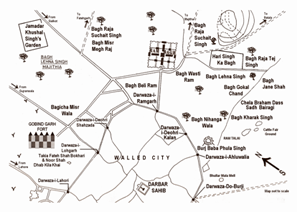
Srinagar (Kashmir, India)
In Srinagar, Hari Singh Nalwa’s garden was situated on the right bank of the Jehlum :
“The river passes within half a mile of the foot of the Tukt, and is nearly two hundred and fifty yards in width, before it enters the city. Its banks are fringed with willows, and among them is a summer-house, with a white cupola, built by the Sikh governor, Huri Singh. An avenue of poplars of nearly a mile in length, runs through the cornfields parallel to it, from the foot of the Tukt, to the Amir’s bridge; close to which is the Shyr Gurh (the city fort), or residence of the Governor…” (Vigne, 1842: (2) 64).
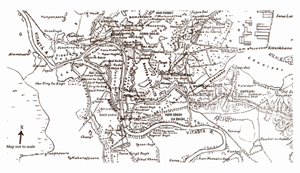
Haripur (Hazara)
Northeast of the fort of Harkishangarh, in the direction of Sikanderpur (Town of Alexander), was an orchard in Haripur known as Hari Singh ka Bagh. The British later converted a portion of Hari Singh ka Bagh at Haripur into a cemetery.
“Pretty little canals cut out of the Dor stream run racing about the town. The borders of Haripur are draped with a voluptuous profusion of jasmine flowers and garden full of prunes and apricots and mango and mulberry. The cool shades of the gardens and flowing canals make Haripur a little, poor man’s paradise in hot summer.” wrote Puran Singh, a poet and resident of Hazara in the early 20th century.
Shrines
Hari Singh Nalwa built a number of religious shrines, including two mosques—one in Haripur and another in Gujranwala (Prem Singh Hoti 1937 : 268).
Panja Sahib Gurdwara in Hassan Abdal (north of Rawalpindi, Pakistan) : Hari Singh Nalwa built this Gurdwara and named it Panja Sahib (Shahamet Ali, 1849: 158-9). This shrine continues to attract a large number of Sikhs from around the world in the 21st century.
Akal Takht, Amritsar :
Hari Singh Nalwa was remembered in the holy city of Amritsar (Punjab, India) for the embellishments he commissioned within the Harmandar Sahib (Golden Temple) complex. He had wished to make the Akal Takht resplendent with gold and had donated a part of his wealth for this purpose.
Accolades
Historians and statesmen have commented on the achievements of Sardar Hari Singh Nalwa :
"...champion of the Khalsaji"
Lepel Griffin (1865). The Panjab Chiefs.
(Bengal Civil Service, Assistant Commissioner, Lahore).
"...builder of the Sikh Empire"
A.S. Sandhu (1935). General Hari Singh Nalwa 1791-1837.
(Sikh historian).
On being asked about the Sikh Kingdom, Mohan Lal informed Abbas Mirza—the Persian Qajar crown prince and military commander during wars with Russia and the Ottoman Empire) :
"...if Sardar Hari Singh were to cross the Indus, his highness would soon be glad to make good his retreat to his original government in Tabriz"
Mohan Lal Kashmiri (1846). Travels in the Panjab, Afghanistan, and Turkistan, etc.
(In service of the East India Company).
"The noblest and the most gallant of the Sikh generals of his time, the very embodiment of honour, chivalry, and courage..."
K.M. Panikkar (1930). The Founding of the Kashmir State.
(Historian, Author, Diplomat and Editor of Hindustan Times).
Stamp Release
Government of India released a postage stamp to commemorate Hari Singh Nalwa
India Post's commemorative postage stamp honouring General Hari Singh Nalwa was released by Shri Kapil Sibal, Minister of Communications & IT, on 30 April 2013. Many serving and retired officers of the Indian Armed Forces and descendants of the leading Sardaris (Misls) of Punjab graced the occasion.
Brigadier Sukhjit Singh, MVC, grandson of Maharaja Jagatjit Singh of Kapurthala, and Sardar Narinder Jit Singh Bindra, Chairman of Uttarakhand Minorities Commission and Prabandhak of the Sri Hemkunt Trust of the renowned Gurdwara Sri Hemkunt Sahib, shared the stage with the Minister. The function was held under the aegis of the Punjabi Academy and Hari Singh Nalwa Foundation Trust at India International Centre in New Delhi. The day of the stamp release marked the 176th anniversary of General Hari Singh Nalwa's martyrdom. He died in 1837, in the Battle of Jamrud fought between the Sikhs and the Afghans at the mouth of the Khyber Pass.
On this occasion, the Minister spoke about Hari Singh Nalwa's military and administrative achievements and secular attitude, which contributed to his stupendous success under very trying circumstances. He referred to Hari Singh Nalwa as a "great nationalist".
The slide-show preceding the stamp release showcased General Hari Singh Nalwa's most significant victories in battle and the geographical areas under his jurisdiction. Killing a tiger with a dagger had earned 'Hari Singh' the cognomen 'Nalwa'. The image depicting this event was taken from an issue of India's largest selling comic book series Amar Chitra Katha created by Anant Pai and published by India Book House.
Shri Sibal released the stamp displayed in a special album. The Minister then unveiled the poster image of the stamp; following which he formally released the biography of General Hari Singh Nalwa in English and Gurmukhi.
The General's portrait reproduced on the stamp is from an oil painting, executed in the 19th or early 20th century in undivided Punjab of British India. At the time of the partition of the Indian subcontinent, this painting was given to India from the vast holding of the Lahore Museum. The painting is presently a part of the collection of the Maharaja Ranjit Singh Museum in Amritsar.
The first day cover depicts Nalwa's Fort of Jamrud. Hari Singh laid the foundation of this fort in 1836, and it still stands sentinal at the entrance to the Khyber Pass. When the fort was built it had 10 feet (3 metre) thick walls. It is today popularly referred to as the Fort of Jamrud, but was originally named 'Fatehgarh' to commemorate the Sikh victory over the Afghans at this frontier. The General's last battle was fought on the vast plain that lay in front of the fort. Following the partition of the Indian subcontinent, this region became a part of Pakistan's North-West Frontier Province and is now known as Khyber Pakhtunkhwa. The Philately Department prepared a brochure for this occasion, which briefly describes the life of General Hari Singh Nalwa.
The programme has been uploaded on YouTube :
Release of Commemorative Postage Stamp & Books
Biography
Hari Singh Nalwa's life and achievements have been documented in English, Gurmukhi, Hindi, Marathi and Urdu :
‘Aman’, Ranjit Singh. (1973). Jeeven General Sardar Hari Singh Nalwa. Amritsar : Shiromani Gurdwara Prabandhak Committee, (Gurmukhi).
Ashok, Shamsher Singh.
— (1950). (ed.) Prachin Jang-Namé. Amritsar : Sikh Gurdwara Prabandhak Committee, (Gurmukhi).
— (1990). Veer Naik Hari Singh Nalwa. Patiala : Panjabi University, (Gurmukhi).
Bhandari, Gopal Das. (1902). Karnama-i-Nalwa. Ambala : Suraj Mall and Co., (Urdu).
Chand, Misr Hari urf Qadaryaar. ‘Jang Peshaur Singha te Pathana di’. In Gobind Singh Lamba (ed.), 1999, Chonnvian Punjabi Siharphian. Patiala : Languages Department, (Gurmukhi).
Das, Narayan. (nd.). General Hari Singh Nalwa. Lahore : Mufid-i-Am Press, (Urdu).
Dayal (Dial), Ram. ‘Jangnama Sardar Hari Singh’. In Ganda Singh (ed.), rpt., 1946, Punjab Dian Varan. Patiala : Panjabi University, 1990, (Gurmukhi).
Gurmat Prakash, Special issue on Hari Singh Nalwa, (May 1992). Amritsar : Dharam Prachaar Committee. 39 : (2), (Gurmukhi).
Hoti, Prem Singh. (1937) 1950. Jeeven Birtant S. Hari Singh Nalwa. Ludhiana : Lahore Book Shop, (Gurmukhi).
Johar, S.S.
— (1982). Hari Singh Nalwa. New Delhi : Sagar.
— (1996). Sikh Warriors: Hari Singh Nalwa. Delhi : National Book Shop.
Kadar Yar. (1925). Sardar Hari Singh Nalwa, Siharfi. Lahore : Gurdial Singh and Son, (Urdu).
Kadaryar. (1840). ‘Siharfi Sadar Hari Singh Nalwa’, In Gurmukh Singh (ed.), 2003, Kadaryar. Chandigarh : Lokgeet Parkashan, 136-40, (Gurmukhi).
‘Kadiryar’, Missar Hari Chand. Si-harfian Hari Singh Nalwa. In Ganda Singh (ed.), 1965. Patiala : Punjabi University, (Gurmukhi).
Kapur, Prithipal Singh (ed.). (1993). Perspectives on Hari Singh Nalwa. Jalandhar : ABS Publications.
Kaushik, A. (2012). Veer Harisingh Nalwa. New Delhi: Hindi Sahitya Sadan, (Hindi).
Kishan, Ram. (1927). Sardar Hari Singh Nalwa. Lahore : Author, Lohari Gate, (Urdu).
Nalwa, V. (2009). Hari Singh Nalwa—Champion of the Khalsaji. New Delhi : Manohar.
Nayyar, G.S.
— (1997). 2005. Life and Accomplishments of Sardar Hari Singh Nalwa Marshal of the Khalsa. Amritsar : Dharam Prachar Committee, Sikh Gurdwara Prabandhak Committee.
—1995. The Campaigns of General Hari Singh Nalwa. Patiala : Punjabi University.
Pai, Anant (ed). (1978). Hari Singh Nalwa, Amar Chitra Katha Series No. 175/774. Bombay : India Book House Pvt . Ltd., (English & Hindi).
Pendse, Vinayak Vishwanath. (1951). Sardar Hari Singh Nalwa. Poona.
Ram, Ghasita. (1907). Karnamah-i-Nalwa. Lahore : Kutab Khana-i-T.C. Gujrati, (Urdu).
Sandhu, A.S. (1935). General Hari Singh Nalwa 1791-1837. Lahore : Cunningham Historical Society.
Seetal, D.S. (1956). Jeevan Sri Hari Singh Nalwa. Amritsar : Seetal Sahit Bhawan, (Gurmukhi).
Singh, Amar. (1903). Chamakda Hira ya Jivan Britant Sri 51 Maan Sardar Hari Singhji Nalwa, Commander-in-Chief Khalsa Fauj, Governor of Peshawar va illaka Hazara etc. Lahore : The Khalsa Agency Lahori, (Gurmukhi).
Singh, Gulcharan. General Hari Singh Nalwa. Sikh Review, 24 (274), Oct. 1979, pp. 36-54.
Singh, Gurmukh. (nd) ‘Siharfi, Jangnama Hari Singh Nalwa’, as reproduced in the Descriptive Catalogue of Manuscripts in Gurmukhi Script, comp. Sardar Singh, 2004. Amritsar : Guru Nanak Dev University, 83.
Singh, Kuldip. (nd.) Sardar Hari Singh Nalwa. Amritsar : Kuldip Press, (Gurmukhi).
Singh, Suraj. (1912). Chamakde Lal, Sardar Hari Singh Nalwa. Amritsar : Chattar Singh Jiwan Singh, (Gurmukhi).
Toofan, Giani Tarlok Singh. (1949). Ankhila Jarnail (Sardar Hari Singh Nalwa). Amritsar : Bhai Mehr Singh Surinder Singh, (Gurmukhi).
Legends
The oral tradition has been robust in the Indian subcontinent and nowhere more than in Punjab. The Punjab Census Report of 1881, revealed the presence of over 150,000 minstrels in the erstwhile Sikh Kingdom (Ibbetson, 1883: 232-3). These wandering musicians sang ballads, folklore and other traditional forms of poetry that often carried a socio-political message. They drew the attention of their audience to the significance of a past event in the light of prevailing conditions. Their songs highlighted acts of heroism.
On the psychological plane, this poetry focused on the struggle between good and evil. Most aspects of their poetry related to actual events. Besides Vars, Jangnamas and other epic forms, the heroic tradition in Punjabi poetry had been preserved through the diverse poetic metre of siharfis, kabits, swayyas, dohras, deodhs, etc.Reference
Ibbetson, D. (1883). Panjab Castes, rpt.1970. Patiala: Languages Department.
Conquest of Sialkot
In 1808, Sardar Jeevan Singh Sialkotia clashed with the fauj or army of the Lahore Darbar. Amar Singh recounted Hari Singh’s role in the conquest of Sialkot. Besides the information culled from Sitarama’s poetic rendition of Hari Singh’s life, this nineteenth-century author/poet also incorporated the narrative of an 85-year-old Sikh soldier. His referral had served as a Subedar of a paltan (platoon) for 28 years in the Sikh Army. He had seen Hari Singh Nalwa many a time. He had also heard of the Sardar’s exploits from those who personally knew him (Amar Singh, 1903 : 2-3).
According to the Subedar’s version, Sardar Hari Singh led the Lahore forces in the Battle of Sialkot. Both sides were evenly matched. On the second day, the Sardar stormed the Qila (fort) along with Hukma Singh Chimni. He scaled the wall and planted the Sikh standard atop the fort (Amar Singh, 1903 : 14-15).
Kadaryar confirms Hari Singh Nalwa’s participation in the conquest of Sialkot :
Ballad speaks...
ਕਾਫ਼—ਕੋਈ ਜਹਾਨ ਤੇ ਨਹੀਂ ਹੋਨਾ, ਹਰੀ ਸਿੰਘ ਜੇਹਾ ਵੱਡੀ ਓਟ ਵਾਲਾ।
ਪਹਿਲਾ ਹਥ ਸਰਕਾਰ ਨੂੰ ਦਸਿਆਸੂ, ਕਿਲਾ ਫ਼ਤਿਹ ਕੀਤਾ ਸਿਆਲਕੋਟ ਵਾਲਾ।
ਦੂਜਾ ਹਥ ਸਰਕਾਰ ਨੂੰ ਦਸਿਆ ਸੂ, ਕਿਲਾ ਮਾਰ ਮੋਇਆ ਜਮਰੌਦ ਵਾਲਾ।
ਕਾਦਰਯਾਰ ਜਹਾਨ ਤੇ ਨਹੀਂ ਰਹਿਣਾ, ਲਸ਼ਕਰ ਮਿਲ ਗਿਆ ਜੇ ਮੁਲਕੁਲ ਮੌਤ ਵਾਲਾ।।੨੨।।
(Qadir Bakhsh urf Kadaryar, 1840)
Kaaf—Koi jahaan te naahi hona, Hari Singh jeha vaddi oat wala,
Pehla hatth Sarkar nu dassya su, Qila fateh keeta Sialkot wala,
Dooja hatth Sarkar nu dassya su, Qila maar moya Jamrud wala,
Kadaryar jahaan te naahi rahena, lashkar milgeya je malkul maut wala. [22]
Kaaf—There is no one in the world who matches Hari Singh’s monumental stature.
His career commenced with the conquest of the fort of Sialkot,
His second major achievement before the Sarkar was when he died defending the fort of Jamrud.
No one, however, lives on in this world when death beckons, says Kadaryar. [22]
Family records maintained by the Pandas in Haridwar, an invaluable source of authentic historical information, provide details of dharamarth grants made by Nalwa to the priests of this place. It was commonplace to bestow a grant on priests, mendicants, religious institutions to mark a significant event in an individual’s life :
Fact or Fiction?
The author of the book 'Hari Singh Nalwa―Champion of the Khalsaji' observes :
Feminine apparel for Pashtuns
In accordance with the teaching of their Guru, the Sikhs did not attack the defenceless or the weak : this included children, women, mendicants and the elderly. Sardar Hari Singh Nalwa advised the Pathans that they could escape the wrath of an infuriated Sikh, were they to adorn the dress of a woman.
In Punjab, the shalwar kameez is feminine apparel. The shalwar is a loose trouser with a stiff border at the ankle, while the kameez was a loose shirt falling to the knees. In India, this dress came to be popularly known as the 'Punjabi suit'. In Pakistan and Afghanistan, men still wear its variant―the 'Pathan suit'.
The following is the gist of an open letter written by Miangul Aurangzeb, the Wali of Swat, to the Taliban, at the time when the Taliban were preaching and enforcing strict dress and conduct codes for the women in the areas that fell under their control :
"At the outset I want to record that you all must love me very much as you have decided not to take over my property in Swat unlike those you have taken over of other landed families. I am therefore emboldened to believe that I have the privilege of sharing some historical facts for you to know about and I urge you to absorb the same before you continue your campaign of moral policing, especially when it comes to the manner of dressing and code of conduct for women.
The Sikh army of Maharaja Ranjit Singh, under the leadership of Hari Singh Nalwa came to the Frontier in the 1820's and swiftly conquered our ancestors. It is the only time in recorded history that our people were ruled over by foreigners. The locals were so utterly terrified of the Sikh army that they used to hide every time the Sikhs came into view. Those that decided to resist were met with ruthlessness. During this time, the word was spread around that the Sikhs did not harm elderly people, women and children and that the local men who did not wish to earn wrath of the Sikhs should wear the garb of Punjabi women, which was the Salwar-Kameez. At that time in our history both men and women alike, wore only a single-robe garment (similar to that worn by the Arabs) and the Sikhs would not harm any man either when wearing the Salwar-Kameez.
So you see, our men happily adopted the garb of Punjabi women since they were too terrified to stand up and they have adopted the garb as being theirs' ever since. I am very intrigued to see that you are following in the footsteps of your ancestors by wearing the adopted Punjabi women's garb as your own, but now go around preaching and coercing our women as to how they should be living their lives! I suggest that take a deep look inside yourselves, given this historical perspective."
Sincerely,
Miangul Aurangzeb,
Wali of Swat.
Reproduced verbatim from 'Nishaan Nagaara', a magazine published by The Nagaara Trust, III/2009, p. 45.
Mistaken Identity!
[Right, top] The photograph supposedly shows Hari Singh Nalwa in the company of Maharaja Ranjit Singh. That this was not a photograph of Hari Singh Nalwa was clear merely from the chronology of events. Hari Singh Nalwa died in 1837 at the age of 46. The supposed Hari Singh Nalwa in the picture is a young man. Though the earliest camera adapted to making a permanent image was developed in the 1820s, photography was first used in India in 1840. Moreover, the dress of those featured in the photograph did not bear resemblance to the mode of the Sikhs.
The photograph in question features Sher Ali, son of Dost Mohammed Khan, two of his advisors and four firangis. The two Afghans standing together behind Sher Ali were mistaken for Hari Singh Nalwa and Fakir Aziz-ud-din.
[Right, bottom] Amir Sher Ali Khan (seated in the centre) ruled for two spells, from 1863-66 and again from 1868-79.
Complicity of Gulab Singh
The year Hari Singh Nalwa was killed in the Battle of Jamrud, the author of Tawarikh Guru Khalsa, Giani Gian Singh, was aged fifteen. Ranjit Singh had appointed the young lad to read out the Holy Scriptures to him.
Some people believed that there was antagonism between the Jammu Dogras and Hari Singh. The revenue collection of Peshawar was in the hands of Gulab Singh Dogra. Yar Mohammed of Peshawar owed thirteen and a half lakh rupees to the Lahore Darbar. Gulab Singh colluded with the Khan. In the Battle of Jamrud, when Sardar Hari Singh was driving the enemy ahead of him, one of Gulab Singh's men in the Sikh army shot the Sardar in his back, from behind. The Sardar stooped over the neck of his horse. At the time people merely suspected Gulab Singh, but when he forgave Yar Mohammed's dues—his complicity became more apparent. Bijay Singh Dogra revealed this information. The Sikhs were greatly pained. Following this, at Gulab Singh's specific request Ranjit Singh granted him Hari Singh's territory. On seeing the treatment meted out to a great Sardar who had conquered so many lands for the Lahore Darbar, many Sikh Sardars were disheartened. Following the death of Sardar Hari Singh Nalwa, no further conquest was made in the direction of the north-west frontier.
(Giani Gian Singh 19th cent.: 390)
The Lahore Court chronicle confirms Gulab Singh's appointment to collect the revenue of Peshawar in 1835 (Sohan Lal Suri 19th cent.: III (2), f. 253). There was, however, one inconsistency in the Giani's narrative. Yar Mohammed died in 1828. The author either incorrectly referred to him, or used his name to refer to the Peshawar Barakzais in general.
Reference
Giani Gian Singh. (1892). Tawarikh Guru Khalsa, ed. K.S Raju, 1999. Patiala: Languages Department, (Gurmukhi).
Suri, Sohan Lal. (19th century). Umdat-ut-tawarikh Daftar III, Part (2), English tr. V.S. Suri, 2002. Amritsar : Guru Nanak Dev University (original in Persian).


